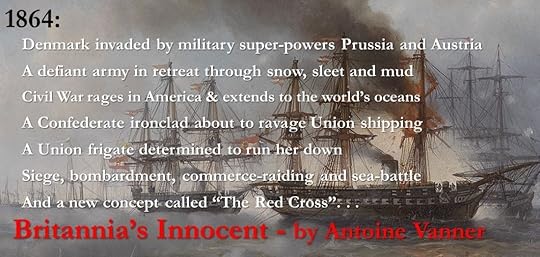Antoine Vanner's Blog, page 12
December 17, 2021
Bayonnaise and HMS Ambuscade action, 1798
 The Bayonnaise and HMS Ambuscade action, 1798
The Bayonnaise and HMS Ambuscade action, 1798On my blog I have dealt several times with single-ship actions during the Age of Fighting Sail, the protagonists being mainly British and French, though the Americans do figure in 1812-15. In most cases British victory over the French seems to have been all but pre-ordained, for the Royal Navy had reached a peak of professionalism in this period and the French officer corps had suffered badly in the revolution, a setback from which it never fully recovered. It is therefore somewhat of a surprise to learn not only of a French vessel, the Bayonnaise capturing a British one, HMS Ambuscade, in a single-ship action, but also that the French vessel was significantly smaller and less powerful.
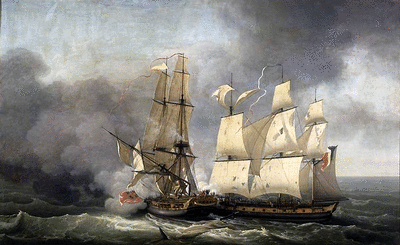 The climax of the action. Bayonnaise (R) rams HMS Ambuscade and the latter’s mizzen falls
The climax of the action. Bayonnaise (R) rams HMS Ambuscade and the latter’s mizzen falls
Painting by Jean Francois Hue, 1751-1823
HMS Ambuscade was, by contrast, much more powerful, a 32-gun frigate that had seen successful service against the French in the American Revolutionary War. Though her dimensions were generally similar to the Bayonnaise , and though she carried a similarly sized crew, her armament was considerably heavier – 26 twelve-pounders, a total of eight six-pounder bow and stern chasers, four eighteen-pounder carronades on the quarterdeck and two on the forecastle. In any ship-to-ship action between the two vessels the Bayonnaise might have been expected to have little chance of survival.
From August 1798, at a time when the Royal Navy’s blockade of the French coast was becoming ever more effective, HMS Ambuscade, commanded by Captain Henry Jenkins, was ordered to patrol off the French Atlantic coast. At dawn on 14th December, when she was cruising off the Gironde estuary, and expecting to meet HMS Stag, she sighted a sail. Assuming this to be the Stag, she steered closer. The newcomer was in fact the Bayonnaise which, significantly as it later proved, was carrying a 40-man army detachment in addition to her own crew. The French ship, recognising that she was outsized and out-gunned, went about and fled. A stern-chase ensued and it was not until noon that the range closed sufficiently for the first shots to be fired.
The action might have ended when HMS Ambuscade crossed Bayonnaise’s stern. This was the most vulnerable part of any sailing man-of-war, as shot crashing through the stern could run longitudinally along the entire inner decks, destroying all in their path. The manoeuvre, if successfully executed, was the deciding factor in many naval battles. It was at this moment of greatest risk that Bayonnaise’s luck kicked in. One of HMS Ambuscade’s 12-pounders burst, killing thirteen around it and destroying the vessel’s boats. In the ensuing confusion Bayonnaise headed south and a new stern chase developed. HMS Ambuscade, recovered from her setback, drew level in mid-afternoon – when, on this winter’s day, only a few hours of daylight still remained.
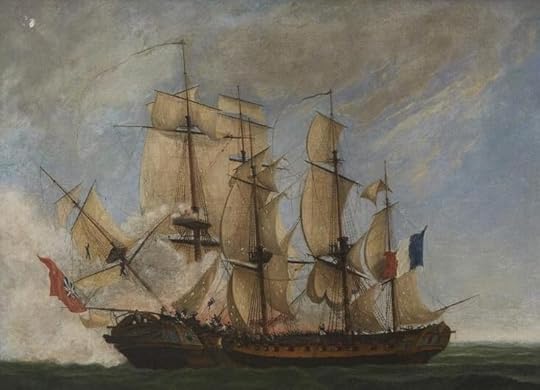
The moment of ramming (note damage to sails) – by naval artist Antoine Roux (1765-1835)
HMS Ambuscade was now sailing parallel to Bayonnaise and well placed to batter her to fragments. Desperate measures were called for if the latter was to survive. Richter, her captain, ordered sail to be backed and swung the helm hard over to port, smashing into HMS Ambuscade’s starboard flank close to the stern. Bayonnaise’s bowsprit crashed into the British frigate’s mizzen mast. It fell, and the tangle of cordage and wrecked spars locked both vessels together.
The extra men Bayonnaise carried – soldiers, accustomed to handling muskets – now proved decisive. A withering fire was directed on Ambuscade’s deck, so many of her officers being wounded that only a single lieutenant was left in command. Bayonnaise too was taking casualties – Captain Richter had an arm shot off – but the advantage now lay with her. French seamen and soldiers clambered across the bowsprit on to Ambuscade and a savage melee developed. Bayonnaise’s new-found luck continued, for a powder charge exploded on Ambuscade’s quarterdeck, inflicting yet more casualties. The fighting continued for another half-hour, but numbers told. When HMS Ambuscade’s colours were finally struck it was by her purser, the last Royal Navy officer still in action.

The most dramatic – and magnificent – representation of all
French boarders can be seen storming across the bowsprit to the Ambuscade
Painting by Louis-Philippe Crepin (1772-1851) in the Musee National de la Marine in Paris
The butcher’s bill for this action was 15 killed and 39 wounded on HMS Ambuscade while Bayonnaise had 25 killed and 30 wounded. The captains of both vessels were among the wounded, and many other officers beside. It should be borne in mind that “wounded” often implied the necessity of amputation of limbs and that death by gangrene was a serious possibility thereafter. As was normal when a captain lost his ship, Captain Jenkins was later court-martialled, though he was exonerated, despite what many considered poor leadership and tactical manoeuvring.
Both vessels were to have active careers thereafter. HMS Ambuscade was taken into French service as Embuscade – wooden ships were almost infinitely repairable if they had not exploded, burned or been sunk. She was however recaptured in 1803 by no less a prestigious ship than HMS Victory, and she resumed her old name. She had an active and successful career thereafter until she was broken up in 1810. Bayonnaise’s luck ran out in 1803, the same year in which Ambuscade/Embuscade’s turned for the better. Run down by HMS Ardent off Cape Finnisterre, her crew burned her rather than surrender.
French pride in the Bayonnaise/Ambuscade action was unbounded – probably because such victories were rare – and eminent artists of the time produced dramatic paintings of it. They convey much of the excitement and drama and some have been used to illustrate this article.
The new Dawlish Chronicles novel is publishedBritannia’s Guile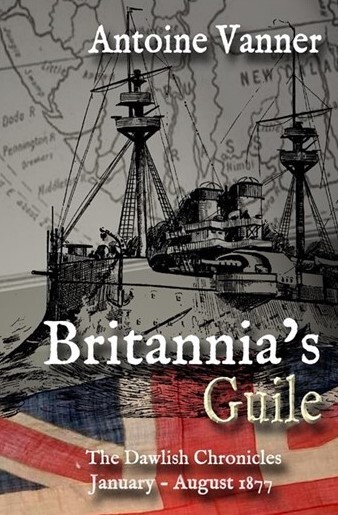 1877: Lieutenant Nicholas Dawlish is hungry for promotion. He’s chosen service on the Royal Navy’s hazardous Anti-Slavery patrol off East Africa for the opportunities it brings to make his name. But a shipment of slaves has slipped through his fingers and now his reputation, and his chance of promotion, are at risk. He’ll stop at nothing to save them, even if the means are illegal . . .
1877: Lieutenant Nicholas Dawlish is hungry for promotion. He’s chosen service on the Royal Navy’s hazardous Anti-Slavery patrol off East Africa for the opportunities it brings to make his name. But a shipment of slaves has slipped through his fingers and now his reputation, and his chance of promotion, are at risk. He’ll stop at nothing to save them, even if the means are illegal . . .
But greater events are underway in Europe. The Russian and Ottoman Empires are drifting ever closer to a war that could draw in other great powers. And Britain cannot stand aside – a Russian victory would spell disaster for her strategic links to India.
The Royal Navy is preparing for a war that might never take place. Dozens of young officers, all as qualified as Dawlish, are hoping for their own commands. He’s just one of many . . . and he lacks the advantages of patronage or family influence. But only a handful of powerful men know how unexpectedly vulnerable Britain will be if war comes. Could this offer Dawlish his chance to advance?
Far from civilisation, dependent on a new and as yet unproven weapon, he’ll face a clever and ruthless enemy in unforeseeable and appalling circumstances.
Only stubborn resolution – and unlikely allies — can bring him through. But at what price?
Britannia’s Guile is set early in the Dawlish Chronicles series (directly ahead of Britannia’s Wolf) and tells how Dawlish met several people who will play major roles in his future career. And they may not all be as they seem . . .
For Kindle or Paperback ordering: US Click Here UK Click HereAustralia & New Zealand Click Here
Members of Kindle Unlimited can read at no extra chargeClick here, or on the banner below, to see details of all books in the Dawlish Chronicles series in chronological order. plus ordering links .fusion-body .fusion-builder-column-0{width:100% !important;margin-top : 0px;margin-bottom : 0px;}.fusion-builder-column-0 > .fusion-column-wrapper {padding-top : 0px !important;padding-right : 0px !important;margin-right : 1.92%;padding-bottom : 0px !important;padding-left : 0px !important;margin-left : 1.92%;}@media only screen and (max-width:1024px) {.fusion-body .fusion-builder-column-0{width:100% !important;}.fusion-builder-column-0 > .fusion-column-wrapper {margin-right : 1.92%;margin-left : 1.92%;}}@media only screen and (max-width:640px) {.fusion-body .fusion-builder-column-0{width:100% !important;}.fusion-builder-column-0 > .fusion-column-wrapper {margin-right : 1.92%;margin-left : 1.92%;}}.fusion-body .fusion-flex-container.fusion-builder-row-1{ padding-top : 0px;margin-top : 0px;padding-right : 20px;padding-bottom : 0px;margin-bottom : 0px;padding-left : 20px;}
The post Bayonnaise and HMS Ambuscade action, 1798 appeared first on dawlish chronicles.
December 9, 2021
Indefatigable vs. Droits de l’Homme
 HMS Indefatigable vs. Droits de l’Homme Desperate action in storm and darkness 1797
HMS Indefatigable vs. Droits de l’Homme Desperate action in storm and darkness 1797Besides their few major fleet actions, the French Revolutionary and Napoleonic Wars saw many vicious encounters between small numbers of French and British ships which have since provided the inspiration for much naval fiction. One of the most ferocious of these battles was fought in the darkness of a stormy winter night off the coast of Brittany in early 1797 and it established Sir Edward Pellew, later to be Lord Exmouth, then captain of HMS Indefatigable, as the foremost frigate captain of the era.
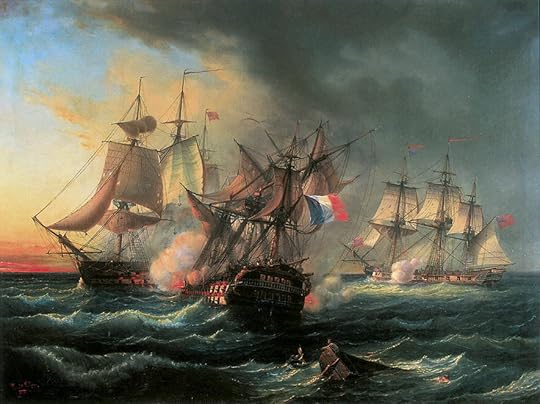
The battle off Brittany 13th January 1797: Painting by Leopold de Guen (1828-1895)
In December 1796, eager to exploit rebellious sentiment in Ireland against British rule, and urged on by Irish exiles, the French Revolutionary Government sent a huge naval and military expedition to open a new theatre of war in Britain’s own backyard. The choice of December may seem a strange one, due to the poor weather that could be expected, but the French relied on this to allow their ships to slip past the blockading Royal Navy squadrons.
The French force left their base at Brest, in Brittany, on December 16th 1796 – seventeen ships-of the-line, thirteen frigates, six corvettes, seven transports, and a storeship. They carried some 20,000 troops under the command of the renowned General Lazare Hoche (1768-97) who, but for his early death (possibly by poison), could have been a rival to Napoleon for supreme power in France. The overall commander was Admiral Morard de Galles, who had established his reputation as one of the great Admiral Suffren’s most successful captains.
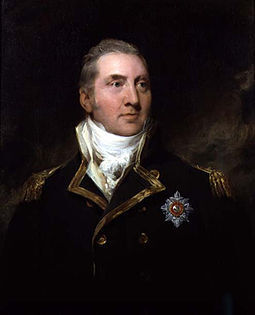 Brest was under observation by the Royal Navy’s inshore squadron, under Captain Sir Edward Pellew (1757-1833), seen on the right, who was already on the way to proving himself one of the greatest commanders of the era. The squadron consisted of four frigates, Pellew himself in HMS Indefatigable, a 44-gun heavy frigate, as well as HMS Revolutionnaire (a French prize taken into British service), HMS Phoebe, and HMS Amazon. When Pellew saw the French emerge he sent off the Revolutionnaire to alert Admiral Sir John Colpoys, who with fifteen of the line would have normally been closer inshore, but who had been blown off station by the same strong easterly winds that facilitated the French departure.
Brest was under observation by the Royal Navy’s inshore squadron, under Captain Sir Edward Pellew (1757-1833), seen on the right, who was already on the way to proving himself one of the greatest commanders of the era. The squadron consisted of four frigates, Pellew himself in HMS Indefatigable, a 44-gun heavy frigate, as well as HMS Revolutionnaire (a French prize taken into British service), HMS Phoebe, and HMS Amazon. When Pellew saw the French emerge he sent off the Revolutionnaire to alert Admiral Sir John Colpoys, who with fifteen of the line would have normally been closer inshore, but who had been blown off station by the same strong easterly winds that facilitated the French departure.
The Revolution had deprived the French Navy of many of its most experienced officers and indiscipline was rampant. Insufficient attention had been paid to training and the presence of strong British forces offshore limited opportunities for acumulating ship-handling experience. The result was that, even in the absence of strong Royal Navy forces, de Galles’ fleet, badly handled in strong wind, lost cohesion on its first day at sea.
As darkness came on, Pellew edged down among the mob of French ships. When de Galles signalled with guns, rockets, and blue lights, Pellew did the same, with variations of his own, completely confusing the French captains. Amid the general disorder that followed, one of the French 74’s, the Seduisant, drove on to a rock and became a total wreck. From 1300 on board only some 600 were saved.
Despite this setback the French evaded Colpoys’ squadron and reached Bantry Bay, in South-West Ireland, in late December. Here storms and fog made landing impossible and the decision was taken to abandon the expedition and return to France. Had it landed, the course of Irish history might have been changed radically.
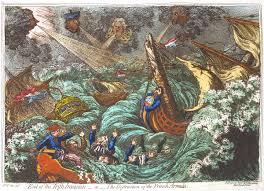
A contemporary British view of the failure of the Bantry Bay Expedition – Cartoon by Gillray
The French straggled home in ones and twos and threes, no longer a fleet. On January 13th, one of the French 74’s, the Droits de l’Homme, commanded by a Captain Raymond de Lacrosse, found herself alone off the coast of Brittany. Visibility was poor and Lacrosse decided to approach no nearer but to sail southward under easy sail, the wind on his starboard beam. In mid-afternoon two sails were spotted on the lee bow, between the Droits de l’Homme and the land. These proved to be Pellew’s HMS Indefatigable, in company with a 36-gun 18-pounder frigate, HMS Amazon, commanded by Captain Robert Reynolds (1745 – 1811). Pellew immediately signalled to HMS Amazon to give chase, and steered towards the enemy, sailing considerably faster than his smaller consort in the heavy sea.
On this winter day dusk fell about four-thirty and the wind, which had been fresh all day, blew a full gale. As darkness came on the Droits de l’Homme lost her fore and main topmasts in a violent squall. Fearing that there might be yet more British ships about, Lacrosse altered course to eastward, and ran straight before the gale, hoping to reach the channel leading to Brest. It was a dangerous decision, as he cannot have been certain about his exact position, and should he have mistaken his landfall, there would be no chance for a crippled ship on a lee shore in such conditions.
At five-thirty, HMS Indefatigable, in near darkness and under close-reefed topsails, surged across the Droits de l’Homme’s stern and raked her. The French ship had nearly a thousand troops on board and they peppered HMS Indefatigable with musket fire as she passed. Pellew’s manoeuvre brought the two vessels so close together that the ensign staff of the French ship fouled HMS Indefatigable’s mizzen rigging and British seamen dragged the tattered remains of the French tricolour on to their own quarterdeck. Lacrosse now tried to bring his vessel alongside, possibly with a view to boarding, difficult as the high seas running would make it, but Pellew managed to sheer away. The Droits de l’Homme’s bowsprit actually grazed HMS Indefatigable’s spanker boom, and she in turn suffered raking fire as she turned away.
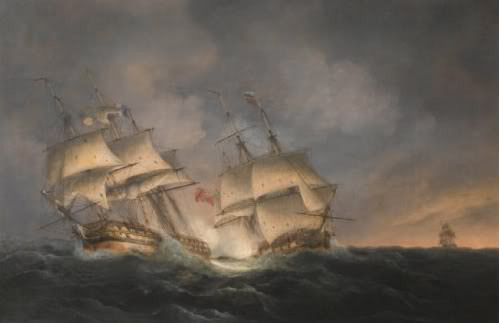
HMS Indefatigable (on right) engages, mid-afternoon – HMS Amazon seen coming up on the horizon
For the next hour and more HMS Indefatigable engaged the French ship-of-the-line single-handedly. In her favour was the fact that in the heavy sea that was running Lacrosse hardly dared open his lower deck gun-ports, and thus lost use of his 36-pounders, his most formidable weapons. The Droits de l’Homme carried 18-pounders in her upper tier, while HMS Indefatigable had an unusually powerful armament for a frigate – 24-pounders on the gun-deck and 42-pounder carronades on the poop and forecastle. In spite of the sea, she fought her 24-pounders right through the action. The loss of his topmasts made it impossible for Lacrosse to steady his ship, and she rolled so furiously that her gunners and small-arms men found aiming difficult.
HMS Amazon arrived out of the darkness shortly before seven o’clock. She blasted a broadside into the Droits de l’Homme but swift action by Lacrosse avoided raking through the stern. Amazon’s manoeuvre had brought both British frigates on the same side of the French ship, masking each other’s fire, so at seven-thirty they both pulled ahead of the enemy. Pellew seems to have been particularly concerned to repair damage to his rigging.
The Droits de l’Homme also needed a respite badly – heavy casualties had been sustained and poor discipline and training had resulted in considerable confusion – but it proved a short one. An hour later Pellew’s two frigates resumed their attack, stationing themselves one on either side of the enemy, and manoeuvring so as to rake her alternately. The Droits de l’Homme attempted to yaw first one way and then the other in order to return their fire, but without much success.
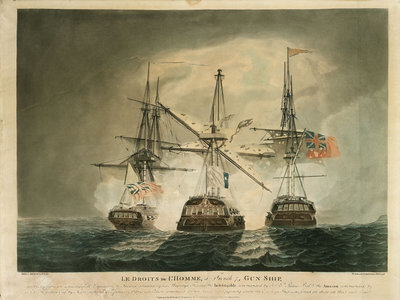
The height of the action, night of 13/14th January – Le Droits de l’Homme sandwiched between Pellew’s two frigates
It is hard to visualise just how ghastly the scene must have been – the high waves, the screaming wind, the crashing guns, the cries of the injured and dying, the enveloping darkness and choking clouds of smoke illuminated by the deafening gunfire. This continued for over two hours.
At ten-thirty the Droits de l’Homme’s mizzen-mast went overboard, and the frigates now positioned themselves off her port and starboard quarter, firing grapeshot so as to hinder any attempt at rigging a jury-mast. Both British ships were rolling so violently that their guns’ breechings – their restraining ropes – were parting and iron ring-bolts in the deck, to which they were fastened were being torn free. The brutal pounding march continued through the night, so heavy that by midnight the French vessel’s store of roundshot was exhausted. And still the British ships blasted without let-up.
At four in the morning, long before daylight, a look-out on HMS Indefatigable reported land directly ahead. Pellew immediately signalled the danger to the Amazon, and hauled his wind southwards while the Amazon bore away to the north. The Droits de l’Homme, possibly oblivious to the danger, held straight on.
All three ships were now in extreme peril. Attack had proved the best form of defence for HMS Indefatigable – her crew’s superior gunnery skills had seen to that. Almost miraculously, no one had been killed and fewer than twenty were wounded, half of them only slightly. She had however suffered severe damage aloft – the French were known for aiming for masts, spars and rigging. The most significant damage was that the shrouds of the main top-mast had been severed. Should this mast fall then HMS Indefatigable could not hope to beat off a lee shore in strong wind under her fore and mizzen topsails only. The hero of the hour proved to be the seaman who was “captain of the maintop”. He went aloft and somehow reached the lurching topmast-head. The end of a hawser was passed up to him and he managed to secure it around the head of the mast. The other end was made fast below and the mast was stabilised. This was perhaps the most heroic exploit of the battle for it was accomplished in darkness, and in a gale, with the swaying topmast threatening to go over at every moment, taking the seaman with it.
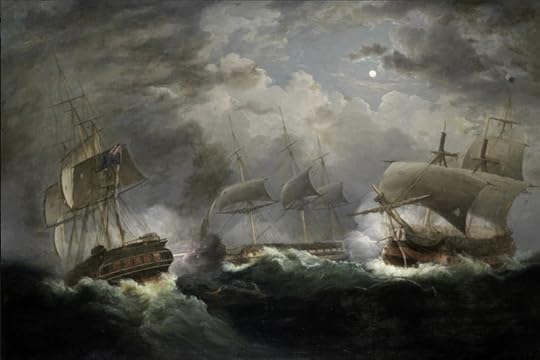
All three ships fighting for survival in Audierne Bay
HMS Indefatigablestood to the south, close-hauled. Then, in the light of dawn, breakers were seen ahead, astern and to starboard. Blindly running before the gale during the night action, all three ships had been entrapped in Brittany’s Audierne Bay.
Pellew wore ship – he “jibed”, a difficult manoeuvre for a square-rigged ship at any time and a daunting one for a damaged one and in the teeth of a gale. Superb professionalism by officers and men alike proved it successful and through the morning Pellew worked towards the safety of the open sea.
HMS Amazon was less lucky. She had taken higher casualties – three killed and fifteen badly wounded – and her masts and spars were badly damaged. Her mizzen topmast, gaff, spanker -boom, and main-topsail yard were gone, and her sails were in shreds. She ran onshore and broke up, but not before all but six of her disciplined crew all came safely ashore on rafts. They were immediately surrounded by French troops and marched off into captivity. It is pleasing to learn that they were well treated. Amazon’s Captain Reynolds was later honourably acquitted by a court-martial for the loss of his ship, and his two lieutenants were promoted.
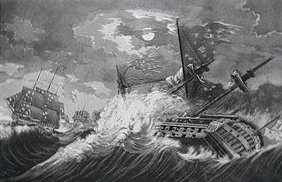
The destruction of Le Droits de l’Homme – Indefatigable seen escaping seawards on the left
A worse fate awaited the Droits de l’Homme. She too ran on to rocks but discipline seems to have broken down and officers proved incapable of regaining control. For the next four days, the survivors clung, cold and starving, to the remains of the wreck until a French brig managed to reach them and get them ashore. Among the survivors was General Jean Joseph Amable Humbert (1767 –1823), who the following year was successful in landing a small French army in Ireland. Humbert’s life was a fascinating – and unlikely – one and worthy of a separate blog in the future.
In the action, the Droits de l’Homme lost over 100 killed, and 150 wounded, from the gunfire of Pellew’s frigates. A British naval officer who was a prisoner on board, and survived, though barely, claimed that after she had run on the rocks about 1000 men drowned or died of starvation and exposure. Just over 400 were saved.
Pellew’s reputation and fame, already great, reached new levels after this action which was an unusual – and perhaps unique – instance of a ship-of-the-line being destroyed by frigates. The circumstances were however exceptional and few captains other than Pellew would have dared turn storm and darkness into weapons against the larger ship.
Few more desperate actions were fought in the Age of Fighting Sail.
The new Dawlish Chronicles novel is publishedBritannia’s Guile 1877: Lieutenant Nicholas Dawlish is hungry for promotion. He’s chosen service on the Royal Navy’s hazardous Anti-Slavery patrol off East Africa for the opportunities it brings to make his name. But a shipment of slaves has slipped through his fingers and now his reputation, and his chance of promotion, are at risk. He’ll stop at nothing to save them, even if the means are illegal . . .
1877: Lieutenant Nicholas Dawlish is hungry for promotion. He’s chosen service on the Royal Navy’s hazardous Anti-Slavery patrol off East Africa for the opportunities it brings to make his name. But a shipment of slaves has slipped through his fingers and now his reputation, and his chance of promotion, are at risk. He’ll stop at nothing to save them, even if the means are illegal . . .
But greater events are underway in Europe. The Russian and Ottoman Empires are drifting ever closer to a war that could draw in other great powers. And Britain cannot stand aside – a Russian victory would spell disaster for her strategic links to India.
The Royal Navy is preparing for a war that might never take place. Dozens of young officers, all as qualified as Dawlish, are hoping for their own commands. He’s just one of many . . . and he lacks the advantages of patronage or family influence. But only a handful of powerful men know how unexpectedly vulnerable Britain will be if war comes. Could this offer Dawlish his chance to advance?
Far from civilisation, dependent on a new and as yet unproven weapon, he’ll face a clever and ruthless enemy in unforeseeable and appalling circumstances.
Only stubborn resolution – and unlikely allies — can bring him through. But at what price?
Britannia’s Guile is set early in the Dawlish Chronicles series (directly ahead of Britannia’s Wolf) and tells how Dawlish met several people who will play major roles in his future career. And they may not all be as they seem . . .
For Kindle or Paperback ordering: US Click Here UK Click HereAustralia & New Zealand Click Here
Members of Kindle Unlimited can read at no extra chargeClick here, or on the banner below, to see details of all books in the Dawlish Chronicles series in chronological order. plus ordering links .fusion-body .fusion-builder-column-0{width:100% !important;margin-top : 0px;margin-bottom : 0px;}.fusion-builder-column-0 > .fusion-column-wrapper {padding-top : 0px !important;padding-right : 0px !important;margin-right : 1.92%;padding-bottom : 0px !important;padding-left : 0px !important;margin-left : 1.92%;}@media only screen and (max-width:1024px) {.fusion-body .fusion-builder-column-0{width:100% !important;}.fusion-builder-column-0 > .fusion-column-wrapper {margin-right : 1.92%;margin-left : 1.92%;}}@media only screen and (max-width:640px) {.fusion-body .fusion-builder-column-0{width:100% !important;}.fusion-builder-column-0 > .fusion-column-wrapper {margin-right : 1.92%;margin-left : 1.92%;}}.fusion-body .fusion-flex-container.fusion-builder-row-1{ padding-top : 0px;margin-top : 0px;padding-right : 20px;padding-bottom : 0px;margin-bottom : 0px;padding-left : 20px;}
The post Indefatigable vs. Droits de l’Homme appeared first on dawlish chronicles.
December 4, 2021
Crimean War’s North Pacific Theatre 1854
 The Crimean War’s North Pacific Theatre:Petropavlovsk, August 1854
The Crimean War’s North Pacific Theatre:Petropavlovsk, August 1854The most common image of the Crimean War (1854 – 56) is of Britain’s Light Brigade charging to death and glory against Russian guns at Balaclava. Almost equally well known are the epics of the ”Thin Red Line” and of the Storming of the Redan, both in the Crimea itself. The more nautically- minded may think of the enormous and costly expedition to the Baltic that earned such scanty returns. Few have however heard of the most remote operation of the war, the Anglo-French assault on Petropavlovsk, Russia’s Northern Pacific port on the Kamchatka peninsula.
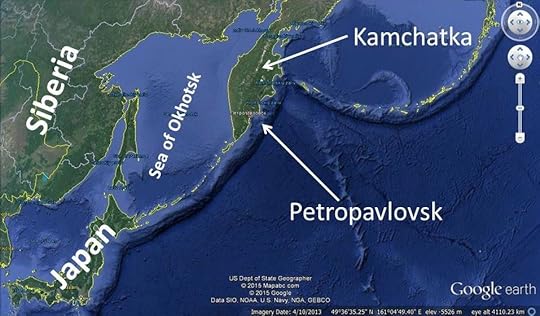
Even for Russians the word “Kamchatka” signified the back of beyond, difficult to the point of near impossibility to reach by land from European Russia. The Trans-Siberian railway had not yet been thought of and would not to be completed for another five decades and the only realistic way of supplying the settlements there was by sea. Kamchatka is a vast peninsula – almost 100,000 square miles – and contains some 160 volcanoes, 29 of them active today – and it is all but cut off from the rest of Siberia by the Sea of Okhotsk. In 1854 Russian presence there was scarcely a century old and the town of Petropavlovsk, founded by the navigator Vitus Bering (of “Strait” fame) in 1740, was important not only as an ice-free port but as a transit point for contact with Russian Alaska. Russia’s interest in Alaska was however never more than lukewarm and its potential was never recognised. It was to be sold to the United States at a knock-down price some thirteen years later.
Petropavlovsk is situated on what a Victorian writer described as “one of the noblest bays in the whole world—glorious Avatcha Bay”. By 1854 the city possessed an almost landlocked harbour, with a sand-spit protecting it from all fear of gales or sudden squalls. The shelter it offered, and its freedom from winter ice, made it an ideal maritime base, and in more recent times has been used as such by the Soviet and Russian Federation Pacific Fleets.
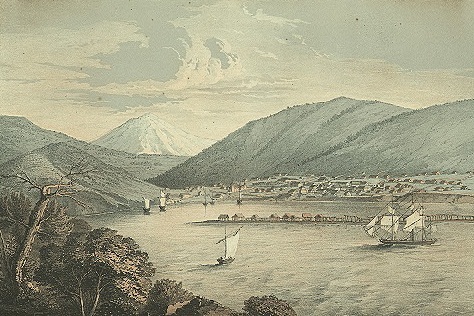
Petropavlovsk in 1856 – at the war’s end. Note the mole protecting the harbour
When Britain, France, Turkey and Piedmont went to war with Russia in 1854 the main theatres of war were to be the Crimea and the Baltic, both offering access by sea. Destruction of the Crimean naval base at Sevastopol and of the Russian fortifications in the Aland Islands, were seen as strategically significant and desirable. It is however impossible to understand how an expedition against Petropavlovsk could ever have been imagined to have any significant impact on the war. Even if held, the occupying force had nowhere else to go and the only Russians inconvenienced would be the two or three thousand engaged in trading in Alaska. Despite this, it was decided that a not-inconsiderable Anglo-French force should be sent against Petropavlovsk. This consisted of six vessels, the Royal Navy’s HMS President (Frigate, 38 guns), HMS Virago (paddle sloop, 6 guns), and HMS Pique (frigate, 36 guns), plus the French La Fort(frigate, 60 guns), Eurydice (corvette, 32-guns), and Obligado (sloop, 32 guns). As only Virago was steam-driven the force was in effect little different from one that might have set to sea in the Napoleonic Wars four decades only. The British commander, the 64-year old Rear-Admiral David Price was himself a veteran of that latter period, having been just promoted after 39 years as a post-captain. The French force was under a Rear-Admiral Auguste Febvrier-Despointes and, as always in allied operations, the potential for miscommunication and confusion was significant. On paper, the Allied force carried some 200 guns, though as almost entirely consisting of broadside ships only half this number could be brought to bear at any one time.
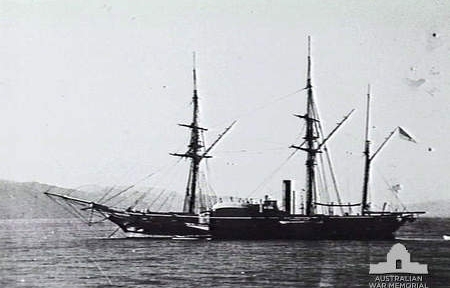
HMS Virago – the only steamship in the Allied force (with acknowledgement to the Australian War Memorial)
The Anglo-French force entered Avatcha Bay on August 28th 1854 (by the Western calendar) and the less wind-dependent Virago was sent to reconnoitre. The town – little more than a village – was protected from the outer bay by a long narrow peninsula on the west, and a sandbank on the east. Vessels passing between these entered the inner harbour and the passage could be closed by a chain. Protective batteries had been located as shown by superimpositions on the contemporary Russian map above – a 5 gun battery at the tip of the peninsula (Battery No.1), an 11 gun battery on the sandbank opposite (Battery No.2) and a 3 gun battery further back along the peninsula (Battery No.3). The total Russian force present amounted to 920 men, seamen as well as soldiers, plus two ships of the Russian Pacific Fleet (indeed almost the entire fleet!), the 44-gun frigate Aurora and the transport Dvina. These were moored inside of the sandpit and effectively protected by Battery No.2, which they supplemented with their own landed guns.
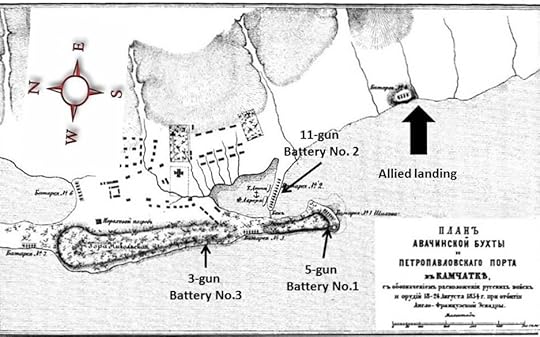
Contemporary Russian Map, with Vanner’s annotations to identify batteries etc.
Virago’s reconnaissance complete, the allied force advanced to bombard the town on August 31st. Proceedings were opened by Rear-Admiral Price going below and shooting himself – whether deliberately or by accident, is unknown – leaving British command to devolve to Captain Nicholson of HMS Pique. The bombardment was suspended but on September 4th the force returned, Virago in the lead, followed by La Fort, President and Pique which were to concentrate fire on Battery No.1 while Eurydice and Obligado took on Battery No.3.
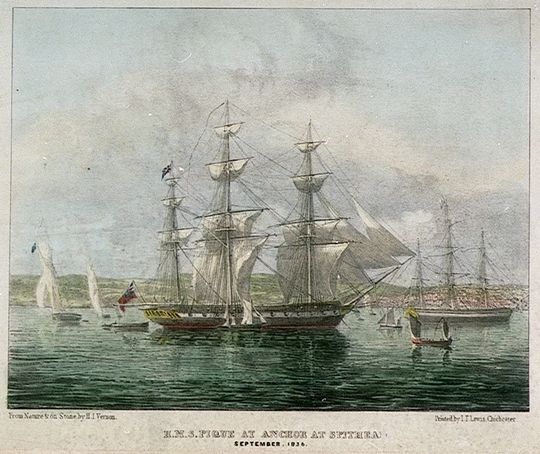
HMS Pique – one of the last sailing frigates, obsolescent when built in 1836
The bombardment proved successful and both batteries were silenced (an unusual occurrence when ships were pitted against shore batteries – indeed Nelson himself had warned that “A ship’s a fool to fight a fort”). Engaging Battery No2 on the sand spit closing off the inner harbour was however a more difficult proposition since insufficient room was available to being all the Allied ships’ guns to bear on it. Taking the town therefore meant landing men. It was however shut in by high hills on almost all sides and the only vulnerable point was in the south, outside the harbour, where a small valley opened out on land bordering the bay (see old Russian map above).
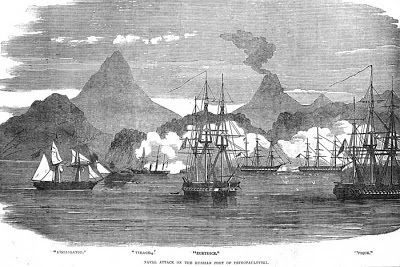
Petropavlovsk under bombardment – a contemporary impression
A landing party of some 680 British and French seamen and marines was hurriedly assembled and sent on shore in boats. The landing was unopposed and the Anglo-French force thrust inland in a straggling, ill-coordinated manner. The ground ahead, rising towards a ridge, was littered with scattered bushes and trees, behind which Cossack sharpshooters had been positioned. They opened a withering fire and picked off nearly every Allied officer. The men, not seeing their enemy and having lost their leaders, fell back in panic-stricken disorder. Many had lost their orientation in the brush and a series of small, vicious combats followed, some of the landed force being most likely shot accidentally by their own side. A number fled up a hill at the rear of the town and were hunted down mercilessly by the Cossacks while others died by falling over the steep cliff on one side of the hill. The guns of La Fort, Virago and Obligado covered the main retreat to the boats, but it was clearly a major defeat. The butcher’s bill was 107 British and 101 French dead or wounded out of the 680 landed. The Russians lost half these numbers and held the field. Allied defeat was total.
There was nothing to be done by the Allies to withdraw, smarting. The winter made the prospect of further action unattractive but a return in force was soon being planned for the following year. Unknown to allies the Russians had decided – wisely – that Petropavlovsk was of little value to themselves, and a potential liability for the Allies, should they take it. Accordingly, in early 1855, the Russian garrison was evacuated.
The Allies were meanwhile assembling a more massive force, with ships assigned to it from the China station. The new commander, Rear Admiral Bruce, organised supplies in Hawaii and a huge supply depot and hospital was organised at Esquimalt, near Vancouver to provide further support. On May 30th 1855 the combined Anglo-French flotilla arrived back at Petropavlovsk in thick fog and took up positions in anticipation of an attack. When the fog cleared two days later reconnaissance revealed the town as deserted. Bruce’s force occupied it without a shot being fired. It was to hold the city until the war came to an end in 1856.
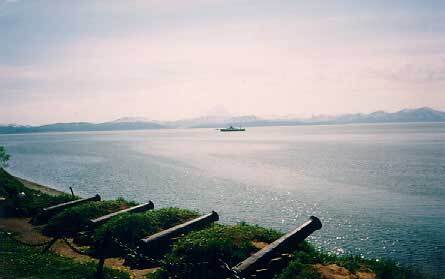
Russian cannon of Battery No.3 looking out over the Bay of Avatcha today
The repulse of the Allies at Petropavlovsk was the only Russian success on any front in the Crimean War and as such is remembered better there than in the West. At a tactical level the operation had more in common with the Napoleonic period – sailing vessels, broadside muzzle-loading artillery, improvised landings – than with the era then dawning. The ironclad would arrive within a decade and, fast in its wake, breech-loaders, torpedoes, efficient steam power and ever-improving armour. At a strategic level the operation, whether a tactical success or failure, could only represent a dead-end squandering of lives and resources.
For Britain and France Petropavlovsk was an embarrassment. And that is, perhaps, why we have heard so little of it since.
The new Dawlish Chronicles novel is publishedBritannia’s GuileAvailable for preorder on Kindle at a reduced price to December 9th 2021 (Links at end of this note). 1877: Lieutenant Nicholas Dawlish is hungry for promotion. He’s chosen service on the Royal Navy’s hazardous Anti-Slavery patrol off East Africa for the opportunities it brings to make his name. But a shipment of slaves has slipped through his fingers and now his reputation, and his chance of promotion, are at risk. He’ll stop at nothing to save them, even if the means are illegal . . .
1877: Lieutenant Nicholas Dawlish is hungry for promotion. He’s chosen service on the Royal Navy’s hazardous Anti-Slavery patrol off East Africa for the opportunities it brings to make his name. But a shipment of slaves has slipped through his fingers and now his reputation, and his chance of promotion, are at risk. He’ll stop at nothing to save them, even if the means are illegal . . .
But greater events are underway in Europe. The Russian and Ottoman Empires are drifting ever closer to a war that could draw in other great powers. And Britain cannot stand aside – a Russian victory would spell disaster for her strategic links to India.
The Royal Navy is preparing for a war that might never take place. Dozens of young officers, all as qualified as Dawlish, are hoping for their own commands. He’s just one of many . . . and he lacks the advantages of patronage or family influence. But only a handful of powerful men know how unexpectedly vulnerable Britain will be if war comes. Could this offer Dawlish his chance to advance?
Far from civilisation, dependent on a new and as yet unproven weapon, he’ll face a clever and ruthless enemy in unforeseeable and appalling circumstances.
Only stubborn resolution – and unlikely allies — can bring him through. But at what price?
Britannia’s Guile is set early in the Dawlish Chronicles series (directly ahead of Britannia’s Wolf) and tells how Dawlish met several people who will play major roles in his future career. And they may not all be as they seem . . .
For Kindle Pre-Ordering:
US Click Here ($2.99 to Dec 9th, $3.99 thereafter)
UK Click Here (£2.99 to Dec 9th, £3.99 thereafter)
Australia & New Zealand Click Here ($3.99 to Dec 9th, 43.99 thereafter)
Members of Kindle Unlimited can read at no extra charge
US Click Here ($12.49 )
UK Click Here (£9.49 )
Australia & New Zealand Click Here ($23.88)
The post Crimean War’s North Pacific Theatre 1854 appeared first on dawlish chronicles.
November 26, 2021
Naval Artist Thomas Luny (1759–1837)
 Naval Artists of the 18th Century – Part 3Thomas Luny (1759–1837)
Naval Artists of the 18th Century – Part 3Thomas Luny (1759–1837)In this article I want to tell of a hero, Thomas Luny, who is known as a great naval painter – but other details of whose life are less familiar. Two sorts of courage move me. The first is the sort of bravery that is called upon for a finite period, for minutes, hours, days or even on occasion months, and which demands a disregard for personal safety and a willingness to risk life and limb of the sake of others. The second is “fortitude”, the determination to endure suffering, privation or personal misfortune over an indefinite period, and still not be defeated. The latter is expressed, unforgettably, by the crippled poet William Ernest Henley (1849–1903):

These words come to mind – for reasons that will emerge later in this article – when looking at the career of the marine artist, Thomas Luny (1759–1837). His work is familiar to many of us, even if we don’t know his name, if we have seen illustration of the Age of Fighting Sail. At a time before photography Luny was one of the artists who had defined our perception of how that age looked and felt. (If you have missed earlier blogs in this occasional series click here and here)
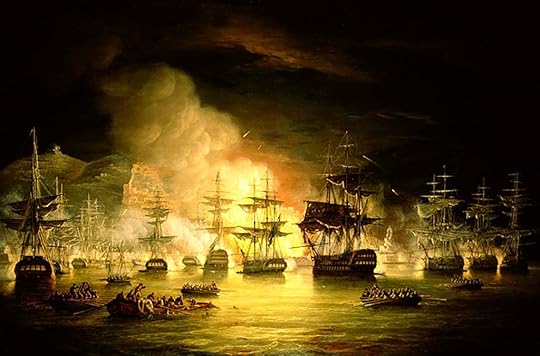
The Bombardment of Algiers, August 1816, by Thomas Luny

Self-portrait in youth
Luny was born in Cornwall – most appropriately in the famed “Year of Victories” when British forces were triumphant on land and sea In Europe and North America. He came to London at the age of eleven and was apprenticed to the marine painter Francis Holman (1729–1784), who was himself son of a master mariner. This apprenticeship proved significant in determining the course of Luny’s career since Holman’s younger brother, Captain John Holman (1733–1816), maintained the family shipping business. The relationship between the brothers appears to have been a close one. Francis would therefore have been in close contact with the maritime world and this showed in the wealth of detail and accuracy in his later work. Talented as Holman was however, it is partly because of his mentorship of the more illustrious Luny that he is now most remembered.
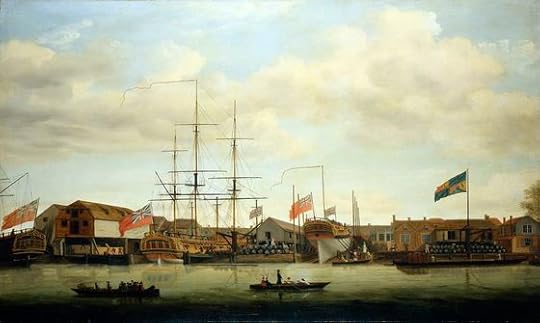
“A small shipyard on the Thames” by Francis Holman, Luny’s mentor
(National Maritime Museum, Greenwich, London, PD-ART-LIFE-70
By 1780 Thomas Luny had shown sufficient talent that he was exhibiting marine paintings in the Royal Academy, and indeed he continued to do so up to 1802. From 1783 Luny lived in London’s Leadenhall Street, and here became acquainted with a dealer and framer of paintings called Merle who subsequently promoted Luny’s work very successfully.
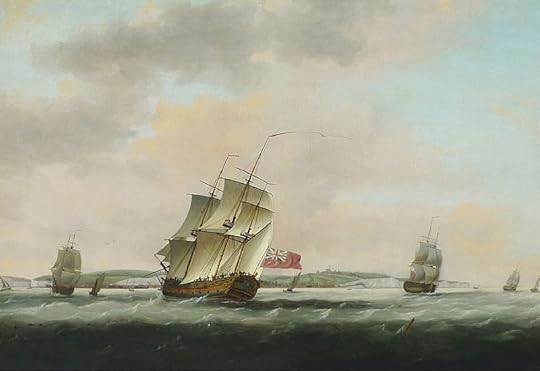
The 18-year old Luny hits his stride: “Shipping off Dover” – 1777
Thomas Luny’s home address in Leadenhall Street was also significant in that it was where the British East India Company had its headquarters. It was from “John Company” that Luny was to receive many commissions for paintings and portraits. This relationship had non-monetary benefits also for, on occasions, Thomas Luny seems to have been invited as a guest on Company ships on special occasions and voyages. This probably accounts for the great detail and realistic look of many of his sketches of locations such as Naples, Gibraltar, and Charleston, South Carolina.
Between 1793 and 1800 Thomas Luny appears to have gone to sea with a purser’s warrant and served with Captain, afterwards Admiral, George Tobin (1768–1838).

George Tobin: Aboriginal hut on Bruny Island, Tasmania, 1792 (Mitchell Library)
One suspects that under Captain Tobin the purser’s duties may have been nominal – a legal fiction for getting Luny to sea. One has the distinct impression that the relationship between Luny and Tobin was very similar to the fictional one between Jack Aubrey and Stephen Maturin, two men of very different characters and aptitudes who nevertheless valued their friendship dearly. One would like to think so. Tobin was himself an artist and the watercolours he made when he sailed with Captain Bligh to Van Diemen’s Land in 1790-1792 are in the Mitchell Library, Sydney (see example above). In this, once again, one sees the Aubrey-Maturin similarity, since in both cases the dissimilar personalities have one shared passion and talent, in the once case for music and in the other for art.
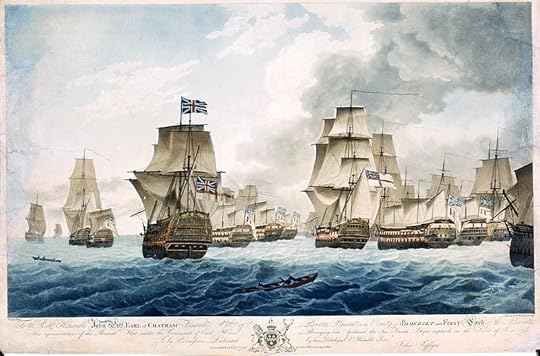
Engraving of Luny’s “The Glorious First of June”
Whether Thomas Luny was present at the battle of the ” Glorious First of June” in 1794 is uncertain, but he painted, among many other marine subjects, several of the incidents of this battle and of the subsequent bringing home of the prizes. It is equally uncertain whether he was on hand for the Battle of the Nile 1798, which he also illustrated spectacularly.
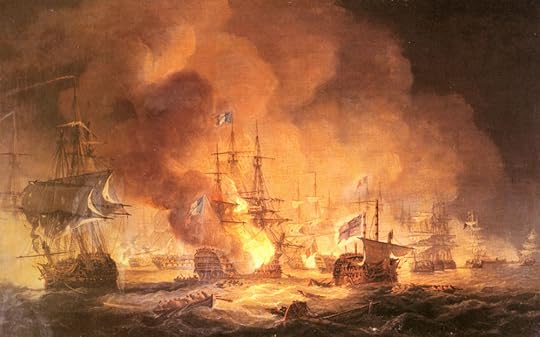
The Battle of the Nile, August 1st 1798, at 10 p.m.
Painted by Luny in 1835, over three decades after he was incapacitated
Up to 1800 Luny’s life had not only been dramatic and adventurous, but also triumphant in professional terms. It was now however that great misfortune fell upon him when he was attacked by rheumatoid of arthritis. It deprived him initially of the use of his feet, and later, cruelly for an artist, it closed his hands so firmly that he could not move his fingers. In this state he moved in 1807 to Teignmouth in Devon, apparently to be his friend Captain Tobin, who had also retired there.
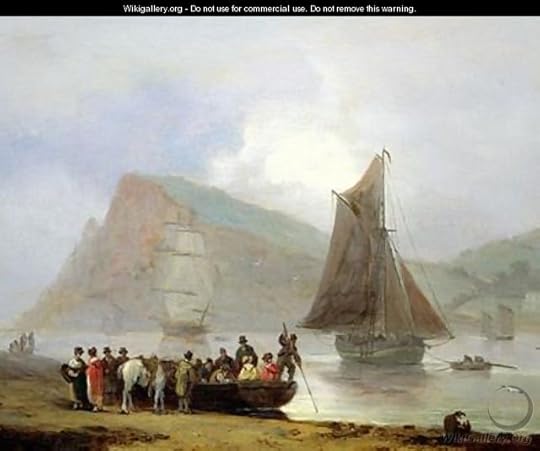
Thomas Luny: “Boarding the ferry at Teignmouth” – painted 1821
(With acknowledgements to Wikigallery)
It was now that Luny’s fortitude and greatness of spirit asserted itself. Despite all his disabilities he continued to paint, receiving numerous commissions from ex-mariners and others, with the same success as before. He was to continue working up to 1835, chair-bound and only able to clutch his brush between hands which could not hold it in his fingers. For delicate manipulation he is said to have held the brush in his mouth. This had no obvious impact on the quality or pace of his artistic work. In fact, of his lifetime oeuvre of over 3,000 works, over 2,200 were produced between his disablement in 1807 and his death. His style is unmistakable.
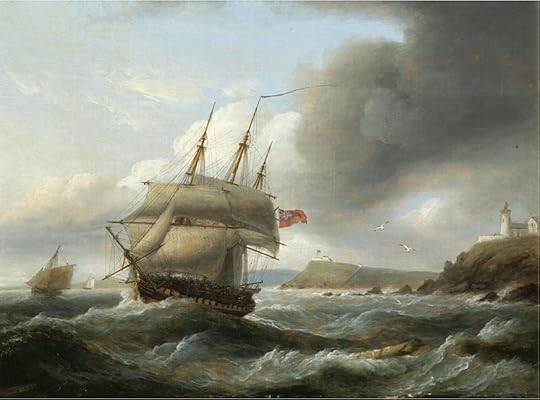
Thomas Luny: “A frigate of the Royal Navy leaving Cork Harbour 1830”
Specimens of Thomas Luny’s work are exhibited at the National Maritime Museum at Greenwich, London, in the Royal Albert Memorial Museum in Exeter, and at The Mariners’ Museum in Newport News, Virginia. If you read this, and if you’re lucky enough to see any of Luny’s work, pay a silent tribute to the memory not only of a great artist, but of a great spirit.
Naval fiction in the Age of Fighting SteamBritannia’s Innocent is the first chronologically of the Dawlish Chronicles SeriesClick here, or on the image below, to read the opening chaptersFor more details regarding purchase in paperback or Kindle format, click below Note that Kindle Unlimited and Kindle Prime subscribers can read at no extra chargeFor amazon.com For amazon.co.uk For amazon.com.auThe Dawlish Chronicles – now up to nine volumes, and with the tenth due for publication in December 2021. Click below for series overview.Six free short-stories are available for download to your Kindle. Access them by registering for the Dawlish Chronicles ma iling list – just click on the banner below. You’ll be kept updated on new books and will receive other free stories at intervals.
.fusion-body .fusion-builder-column-0{width:100% !important;margin-top : 0px;margin-bottom : 0px;}.fusion-builder-column-0 > .fusion-column-wrapper {padding-top : 0px !important;padding-right : 0px !important;margin-right : 1.92%;padding-bottom : 0px !important;padding-left : 0px !important;margin-left : 1.92%;}@media only screen and (max-width:1024px) {.fusion-body .fusion-builder-column-0{width:100% !important;}.fusion-builder-column-0 > .fusion-column-wrapper {margin-right : 1.92%;margin-left : 1.92%;}}@media only screen and (max-width:640px) {.fusion-body .fusion-builder-column-0{width:100% !important;}.fusion-builder-column-0 > .fusion-column-wrapper {margin-right : 1.92%;margin-left : 1.92%;}}.fusion-body .fusion-flex-container.fusion-builder-row-1{ padding-top : 0px;margin-top : 0px;padding-right : 20px;padding-bottom : 0px;margin-bottom : 0px;padding-left : 20px;}The post Naval Artist Thomas Luny (1759–1837) appeared first on dawlish chronicles.
November 19, 2021
Battle of Caulk’s Field 1814
 Caulk’s Field: the Death of Captain Sir Peter Parker, 1814
Caulk’s Field: the Death of Captain Sir Peter Parker, 1814The British attack on Baltimore in mid-September 1814, and the heroic defence of Fort McHenry, is one of the most widely remembered incidents of the War of 1812, since it was to inspire the writing of the American national anthem. It was however preceded by a British amphibious attack on the eastern shore of Upper Chesapeake Bay, directly across from the city, on August 31st. A force of seamen and marines were landed from a British frigate and were soundly beaten in an engagement known as the Battle of Caulk’s Field. At this remove the landing appears to be an unwise one that could have achieved little or nothing as regards the larger operation against the city.
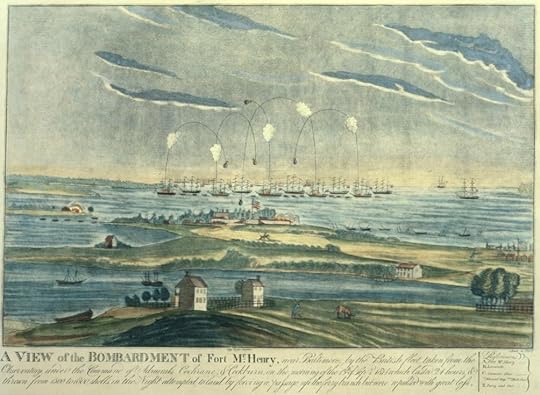 The attack on Fort McHenry – the inspiration for “The Star-Spangled Banner”
The attack on Fort McHenry – the inspiration for “The Star-Spangled Banner”
The Caulk’s Field battle did however result in the death of a young Royal Navy captain, Sir Peter Parker (1785-1814), and the manner of his passing was to be widely admired. The account that follows focusses on this, rather than on the battle. It draws heavily on Edward Giffard’s “Deeds of Naval Daring” (1852)and it casts light not only on the warmth of relations between enlisted seaman and admired officers, but on the discrepancies that arise between accounts from different sources, in this case British and American.
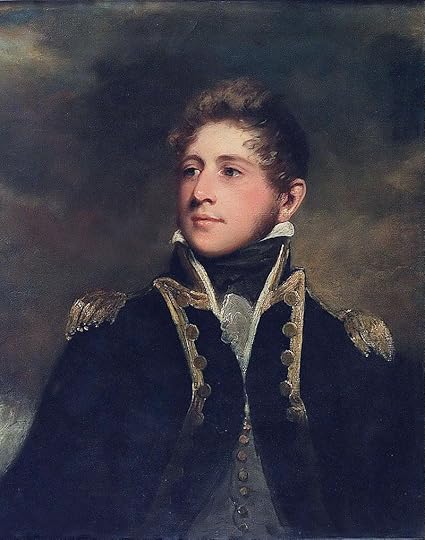
Parker – young, handsome and brave
Sir Peter Parker was the grandson of Vice Admiral John Byron (1713-1786), known as “Foul Weather Jack” and as such first cousin of Lord Byron. the poet. He had entered the navy in 1798 and by 1805 he was in command of the brig HMS Weazel which was the first British vessel to sight the enemy fleet exiting Cádiz prior to the Battle of Trafalgar. By 1810 he was not only a captain, but had been given command, at the age of 25, of the new frigate HMS Menalaus. His first duty was to provide assistance in suppression of a mutiny in the frigate HMS Africaine, after which he gave meritorious service in the Mediterranean and Indian Ocean. In 1813, with the “War of 1812” between Britain and the United States in full swing, the Menelaus was transferred to duties off the American eastern seaboard.
In August 1814 Parker was in the Upper Chesapeake with Menelaus and preparations were in hand for the British attack that would come a fortnight later. According to Giffard, Parker “received information from an intelligent black man that a body of militia were encamped behind a wood within sight of the ship.” Parker therefore decided on making a surprise landing, staging a night attack and storming the militia camp. He would lead the raid personally. Just before midnight on 30th August 1814 he landed a force of seamen and marines, some 140 in total and divided them into two groups headed by two of his Lieutenants, Crease and Pearce. He seems to have been well aware of just how dangerous – perhaps even foolhardy – the undertaking was and he wrote a short letter to his wife, as follows:
Menelaus, August 30, 1814
I am just going on desperate service, and entirely depend upon valour and example for its successful issue. If anything befalls me, I have made a sort of will. My country will be good to you and our adored children. God Almighty bless and protect you all!
Adieu, most beloved Marianne, Adieu!
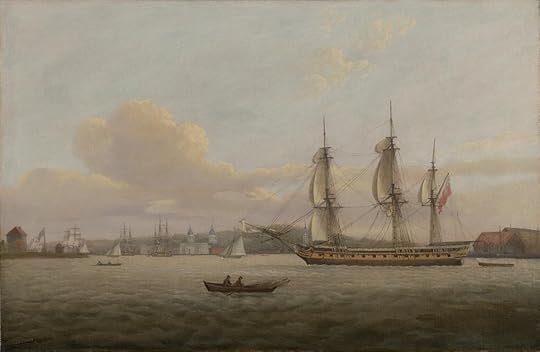
HMS Pomone: a typical frigate of the time, which Menelaus would have resembled
(Painting by the great Thomas Luny)
Menelaus’s landing party captured several guards without apparently raising any great alarm and advanced in silence towards the militia camp. On arrival there they found that the enemy had moved. In strange country, and in darkness, discretion might have called for a return to the ship but Parker decided to press on. What followed was to be known as Battle of Caulk’s Field, near Fairlee. The naval force advanced some four to five miles only to find itself confronted by force of 500 militia, a troop of cavalry and five artillery pieces drawn up in line on a plain surrounded by woods. Faced with such superiority, Parker decided that his only hope lay in an immediate attack. “By a smart fire, and instant charge, the enemy was driven from his position, completely routed, and compelled to a rapid retreat behind his artillery, where he again made a stand; one of his guns was captured, but again abandoned. The attack was instantly renewed with the same desperate gallantry.”
It was at this point, as later reported in the London Gazette, that “while animating his men in the most heroic manner, that Sir Peter Parker received his mortal wound, which obliged him to quit the field, and he expired in a few minutes.”
Giffard stated that “The ball by which Parker fell entered his right thigh, and cut the main artery. On receiving his mortal wound he smiled, and said, “They have hit me, Pearce, at last; but it is nothing. Push on, my brave fellows, and follow me!” Cheering his men with undaunted heroism of spirit, that even his dying accents may be said to have been strains of triumph. The latter as enthusiastically returned his cheer. He advanced at their head a few paces further, when, staggering under the rapid flow of blood from his wound, he grew weak, fell into the arms of his Second Lieutenant, Mr. Pearce, and, faintly desiring him to sound the bugle; to collect the men, and leave him on the field, he finally surrendered, without a sigh or a pang, his brave spirit to the mercy of Heaven.”
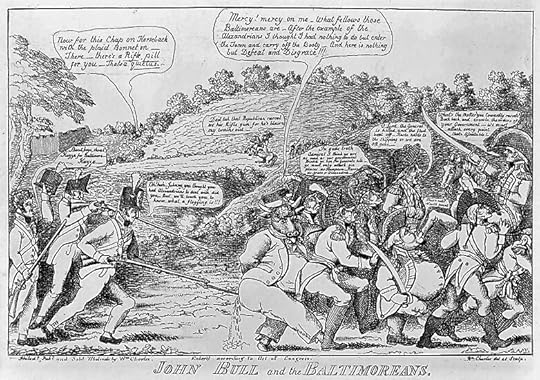
This cartoon conveys something of the American urge to resist the British. Note that John Bull is shown as a real bull!
A newspaper, the Boston Independent Chronicle, gave a different account on September 12, 1814 of Parker’s death. It estimated Parker’s force at between 200 and 300 – clearly too much to be landed from a single frigate. It attributed Parker’s wound to buckshot that hit him on the head as well as in the leg. (A son of a militiaman participant claimed later that his father had struck Parker down with by a ”blunder-buss loaded to the muzzle with all the hardware, bolts, nuts, nails, etc”). The newspaper reported five British dead, besides Parker, as well as five wounded, two of whom were to die. There appears to have been no American deaths and only three wounded.
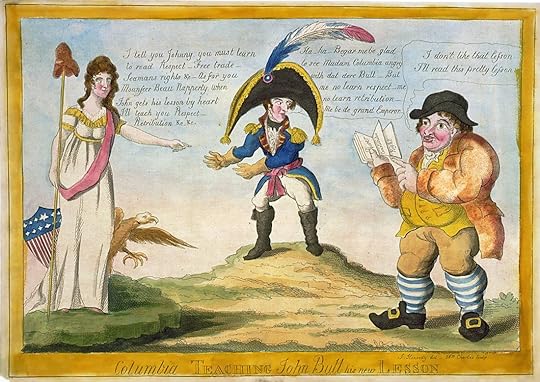
An American view of Britain during the War of 1812: Virtuous Columbia (l) admonishes t he coarse John Bull (r) while Napoleon, in the middle, enjoys the spectacle
Retreat was now the only option for the Menelaus landing party. It was now that the Parker’s crew was to demonstrate the respect and affection that inspirational leaders so often earned from the lower deck. Several of “his men collected around his body, and swore never to deliver it up to the enemy but with their lives.” Lieutenant Pearce had them carry the body on their shoulders ”who, relieving each other by turns, thus bore off to the shore (a distance of five miles) the body of their fallen and beloved commander. One of these, William Porrell, seaman, evinced on this occasion a personal bravery and attachment to his Captain that would have done credit to any mind. This man was near Sir Peter when he received the fatal wound, and immediately ran to his assistance, and supported him in his arms until further help was procured. The men who bore him off were changed occasionally, but Porrell refused to quit the body a moment, and, unrelieved, sustained his portion of the weight to the shore. When it was suggested by some present that the enemy might rally, and cut off their retreat, he exclaimed, ‘No d —d Yankee shall lay a hand on the body of my Captain while I have life or strength to defend it.’”
[image error]
“The Press Gang” by Luke Clennell (1781 – 1840) – an institution often inaccurately understood. Regardless of how recruited, seamen’s loyalty to admired officers was always high.
Porrell was not the only seaman to display remarkable resolution at Caulk’s Field. A twenty-four year old, James Perring, had been seriously wounded early in the action. In considerable pain he urged his companions to leave him and advance, swearing that “he would never become the prisoner of a Yankee. He subsequently crawled to a tree, against which, in great agony, he seated himself, with his cutlass in one hand and his pistol in the other.” He was found by the Americans after dawn when “finding the British had retreated, (they) returned to the field of battle for the humane purpose of collecting the wounded.” Perring was clearly dying and they summoned him to surrender. He answered that no American should ever take him alive. They assured him they only wanted to carry him off to the hospital. He persevered in refusing to receive succour from He was told, if he refused giving up they must fire on him. Collecting his strength, he exclaimed “Fire away, be d-d! No Yankee shall ever take me alive; you will only shorten an hour’s misery!” The Americans respected the heroism of this brave young man, and left him unmolested to die on the field.”
Parker’s body was sent home and was subsequently interred at the family vault at St Margaret’s, Westminster (the separate church adjoining Westminster Abbey), and the eulogy was delivered by his first cousin, Lord Byron. One wonders what would not subsequently have lain in the future for this dashing young frigate captain who was struck down at Caulk’s Field at the age of twenty-nine.
Reduced Kindle-Price offer: Britannia’s Gamble, November 19th to 22nd, 2021
Click on image to learn more
Like all the Dawlish Chronicles novels, Britannia’s Gamble can be read as a “stand alone”. It’s especially dear to me since the genesis of the plot goes back to my first reading about General Charles Gordon, the quintessential Victorian hero, when I was a boy.
Recent events in Kabul have reminded me of the plight that Gordon found himself in Khartoum in 1884-85. A fanatical Islamist revolt had swept across the vast wastes of the Sudan and was establishing a rule of persecution and terror. Only the city of Khartoum held out, the defence of its population masterminded by Gordon. Though his position was weakening by the day and a relief force might never reach him, he remained “the Good Shepherd who would not desert his flock.” It was an eric defence and it is at the heart of Britannia’s Gamble, which tells of Captain Nicholas Dawlish’s role in the rescue attempt, one not widely known about before . . .
I’m making the Kindle edition of Britannia’s Gamble available at half- price from Friday 19th November to Monday 22nd November inclusive.
On Amazon.com – Click: https://amzn.to/3FobyoL
Kindle: $1.99 (Usual Price $3.99)
On Amazon.co.uk – Click: https://amzn.to/3wUBt4m
Kindle: £1.99 (Usual Price £3.49)
.fusion-body .fusion-builder-column-0{width:100% !important;margin-top : 0px;margin-bottom : 0px;}.fusion-builder-column-0 > .fusion-column-wrapper {padding-top : 0px !important;padding-right : 0px !important;margin-right : 1.92%;padding-bottom : 0px !important;padding-left : 0px !important;margin-left : 1.92%;}@media only screen and (max-width:1024px) {.fusion-body .fusion-builder-column-0{width:100% !important;}.fusion-builder-column-0 > .fusion-column-wrapper {margin-right : 1.92%;margin-left : 1.92%;}}@media only screen and (max-width:640px) {.fusion-body .fusion-builder-column-0{width:100% !important;}.fusion-builder-column-0 > .fusion-column-wrapper {margin-right : 1.92%;margin-left : 1.92%;}}.fusion-body .fusion-flex-container.fusion-builder-row-1{ padding-top : 0px;margin-top : 0px;padding-right : 20px;padding-bottom : 0px;margin-bottom : 0px;padding-left : 20px;}The post Battle of Caulk’s Field 1814 appeared first on dawlish chronicles.
October 29, 2021
6ths at bay – HMS Flamborough and HMS Bideford, 1760
 HMS Flamborough and HMS Bideford –Outgunned but Defiant, 1760
HMS Flamborough and HMS Bideford –Outgunned but Defiant, 1760The term “post ship” was applied in the Royal Navy to Sixth-Rate vessels, and referred to the fact that they were the smallest ships that could be commanded by a post-captain. They were in effect miniature frigates, ship-rigged, some hundred feet long and around 500 tons armed with 20 to 26 long guns, typically nine pounders. They tended to be slow and for this reason were often used as convoy escorts.
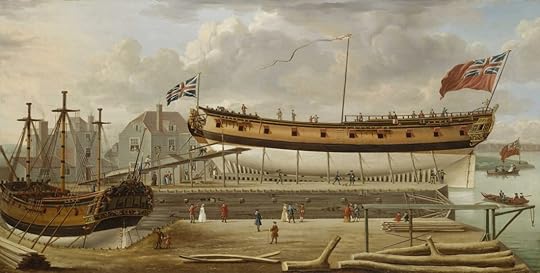 A Sixth-Rate on the Stocks by John Cleveley the Elder (1712 – 1777)
A Sixth-Rate on the Stocks by John Cleveley the Elder (1712 – 1777)
Given competent and determined commanders, Sixth-Rates could however give a very good account of themselves. One of the most notable instances of this occurred during the Seven Years War, when two such vessels, HMS Bideford and HMS Flamborough, each of 20 guns, fought a spectacular action against two larger and more powerful French frigates.
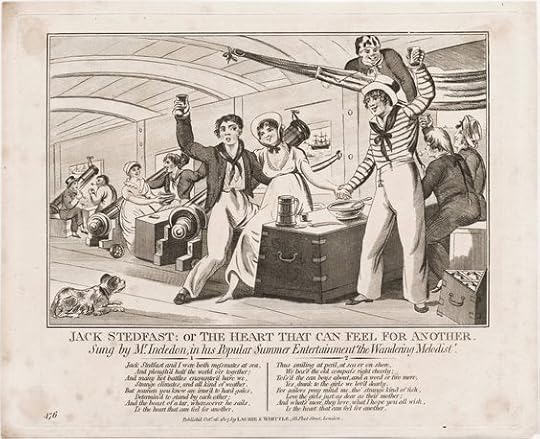
The spirit of “British Tar” was, no less than the professionalism of his officers, the foundation of the Royal Navy’s dominance in the Age of Fighting Sail. He was widely admired and often the subject of the pop-songs of the time, as shown here.
In April 1760 HMS Flamborough, commanded by a Captain Archibald Kennedy, and HMS Bideford, commanded by a Captain Skinner, were cruising off the Portuguese coast, close to the mouth of the Tagus. A valuable British convoy, escorted by a single sloop, was in the general area, but apparently out of sight. In the course of the day what appeared to be possibly four enemy ships were seen running before the wind. The two British ships were well to leeward and despite this, and the disparity in numbers, headed for the strangers.
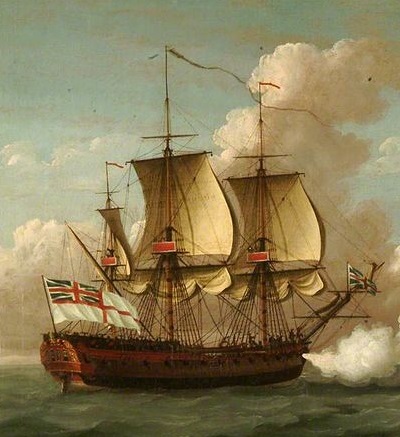
HMS Brune, a frigate captured from the French in 1761. The French frigates engaged by HMS Flamborough and HMS Bideford would have resembled this vessel. (Painting by John Cleveley the Elder, 1712 — 1777)
Captain Kennedy’s HMS Flamborough was the better sailer of the two British ships and by mid-afternoon got within distant gunshot range, opening fire on the closest ship – now clearly French. Rather than immediately engaging ship-to-ship, the French vessel signalled for two of her consorts to sail on and the third to join her in an attack on HMS Flamborough. Followed by the French – the frigates la Malicieuse (36 guns) and l’Omphale (32 guns) – Captain Kennedy retreated to join HMS Bideford. They met at around six o’clock. Despite the firepower advantage being in their favour, the French vessels now attempted to avoid action and ran.
As so often when reading accounts of combat in the Age of Fighting Sail, one is impressed by the aggressive self-confidence of Royal Navy officers. So it was in this case. The more powerful ships were in flight, the weaker in pursuit, as HMS Flamborough and HMS Bideford chased the retreating French. HMS Flamborough, first came up with the sternmost French frigate, delivered a single broadside and pressed on, leaving her to be dealt with by Bideford. At half-past six o’clock, in twilight, HMS Flamborough came up with the leading French vessel, drew as close as possible without being able to board, or be boarded, and began a cannonade.
This slogging match continued until nine o’clock, by which time darkness had fallen. It’s hard to imagine what this must have sounded and felt like. Even a portrayal of a ship-to-ship action as realistic as that in the Master and Commander movie lasts only minutes on screen. HMS Flamborough and her opponent were at it for two and a half hours. By the time firing ceased – temporarily as it proved – the Flamborough’s masts, sails and running rigging were so badly damaged as to make her un-navigable and a number of serious hits had been sustained on the hull “betwixt wind and water”. During this pause, the British crew worked with such energy that control was regained within half an hour and the action resumed. At eleven o’clock, after another ninety minutes of close combat, the French frigate broke off the action and made off, pursued by the badly damaged Flamborough until noon on the following day.
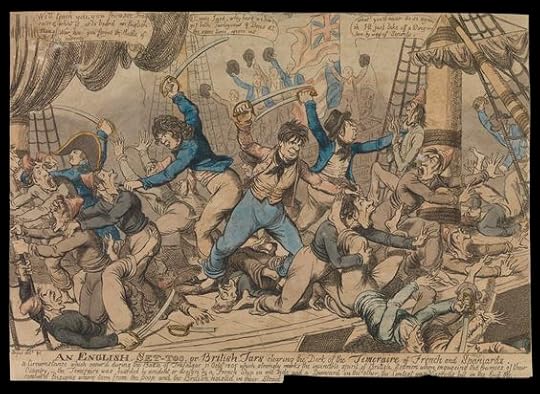
The aggressive and bloody-minded attitude of British seamen was widely admired – and feared.
HMS Bideford had also been heavily engaged. Shortly after seven o’clock – in darkness – she caught up with the French frigate that had been mauled by HMS Flamborough’s first broadside and attacked her. Bideford’s Captain Skinner was killed by a cannon-shot soon after and her Lieutenant Knollis, who now took command, fought on with determination for another hour until he was badly wounded and carried, dying, below. By this stage, Bideford’s spars and rigging had been damaged and casualties sustained. Morale remained high however and the master, a Mr, State, now senior officer, maintained the action. By ten o’clock the French ship’s fire slackened, her guns falling silent one by one. Intent on capturing her, Mr. State, who thought the enemy was going to strike, still continued his broadsides. In the last quarter-hour of combat, only four French guns fired. Under cover of darkness, but still being pounded, the French crew was however concentrating on repair of rigging. This proved so successful that the French frigate managed to draw away while Bideford, damaged and disabled, was unable to follow.
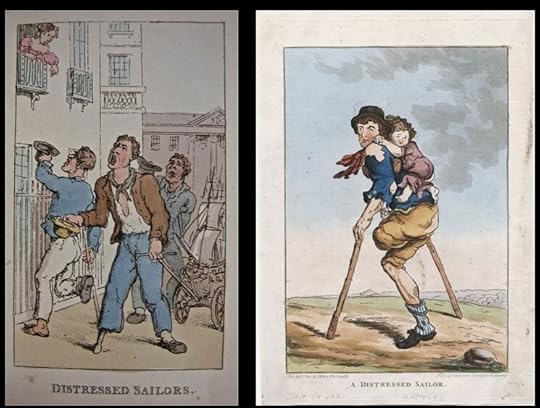
In an age when amputation was the only option for fighting gangrene, wounds sustained in battle could mean a lifetime of destitution in a nation that lauded its fighting men but didn’t care for them afterwards. (Has it really changed all that much?)
In the event, both French warships escaped, albeit seriously damaged, outfought by two smaller and more weakly armed ships. Considering the duration and intensity of the battle one is surprised that the British losses were relatively low – though grievous for the individuals concerned. Five officers and men were killed on board HMS Flamborough, and ten wounded, while HMS Bideford had ten killed and twenty-five wounded. Crews on each ship would have been around 130. Losses might have been higher had the action been fought in daylight, when accurate small-arms fire could have been poured down from fighting tops. Sending the French vessels to flight had the added advantage of protecting the convoy mentioned earlier. It was close enough to have heard the gunfire and it proceeded unmolested on its course.
The most remarkable feature of this action is the role played by morale. The decision of the British captains, outnumbered and outgunned as they were, to take the offensive from the start put the French on the back foot. They had lost the morale advantage even before Flamborough’s first broadside and it was never regained. The old saying that “what matters is not the size of the dog in the fight, but the size of the fight in the dog”, was once again proved valid.
Britannia’s MissionThis volume in the Dawlish Chronicle series is published in paperback and on Kindle, and is available to subscribers to Kindle Unlimited and Prime at no extra chargeClick image for details or to order
1883: The slave trade flourishes in the Indian Ocean, a profitable trail of death and misery leading from ravaged African villages to the insatiable markets of Arabia. Britain is committed to its suppression but now there is pressure for more vigorous action . . .
Two Arab sultanates on the East African coast control access to the interior. Britain is reluctant to occupy them but cannot afford to let any other European power do so either. But now the recently-established German Empire is showing interest in colonial expansion . . .
With instructions that can be disowned in case of failure, Captain Nicholas Dawlish must plunge into this imbroglio to defend British interests. He’ll be supported by the crews of his cruiser HMS Leonidas, and a smaller warship. But it’s not going to be so straightforward . . .
Getting his fighting force up a shallow, fever-ridden river to the mission is only the beginning for Dawlish. Atrocities lie ahead, battles on land and in swamp also, and strange alliances must be made.
And the ultimate arbiters may be the guns of HMS Leonidas and those of her counterpart from the Imperial German Navy.
In Britannia’s Mission Nicholas Dawlish faces cunning, greed and limitless cruelty. Success will be elusive . . . and perhaps impossible.
Registering for the Dawlish Chronicles mailing list by clicking on any one of the images below, will keep you updated on new books and facilitate e-mail contact between Antoine Vanner and his readers. You’ll also get six free short stories to upload to your Kindle or Tablet.
.fusion-body .fusion-builder-column-0{width:100% !important;margin-top : 0px;margin-bottom : 0px;}.fusion-builder-column-0 > .fusion-column-wrapper {padding-top : 0px !important;padding-right : 0px !important;margin-right : 1.92%;padding-bottom : 0px !important;padding-left : 0px !important;margin-left : 1.92%;}@media only screen and (max-width:1024px) {.fusion-body .fusion-builder-column-0{width:100% !important;}.fusion-builder-column-0 > .fusion-column-wrapper {margin-right : 1.92%;margin-left : 1.92%;}}@media only screen and (max-width:640px) {.fusion-body .fusion-builder-column-0{width:100% !important;}.fusion-builder-column-0 > .fusion-column-wrapper {margin-right : 1.92%;margin-left : 1.92%;}}.fusion-body .fusion-flex-container.fusion-builder-row-1{ padding-top : 0px;margin-top : 0px;padding-right : 20px;padding-bottom : 0px;margin-bottom : 0px;padding-left : 20px;}
The post 6ths at bay – HMS Flamborough and HMS Bideford, 1760 appeared first on dawlish chronicles.
October 22, 2021
Hoche Ramming Disaster 1892
 Another peacetime ramming disaster:Hoche and Maréchal Canrobert 1892
Another peacetime ramming disaster:Hoche and Maréchal Canrobert 1892Ramming proved a successful manoeuvre in battle on only one naval battle – at Lissa in 1866 (click here to access an earlier blog-article about it) – but ram bows were seen as essential features for warships of almost all sizes in the half-century prior to WW1. Such bows – extended forward underwater to end in a sharp point that could gouge deep into an enemy hull – were to prove a major hazard in peacetime. Naval vessels exercising manoeuvres in close proximity to each other were obviously most at risk. Accidental ramming was to prove fatal in several major “blue on blue” disasters, several of which are described in the “Victorian Era” part of this site’s “Conflict” section (Click here to access). The tragedy of it all was that ramming would have been very difficult to achieve under modern battle conditions since improved long-distance gunnery, and higher ship speeds, would have made it virtually impossible to ram a major enemy vessel.
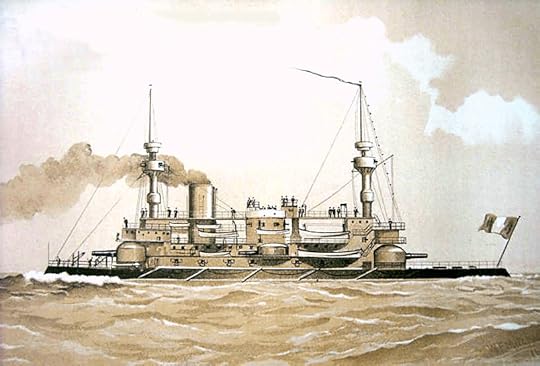
“Le Grand Hotel”
Another addition to the sad list of ramming disasters occurred in July 1892 and involved the French battleship Hoche. When she entered service in 1890, this vessel represented the epitome of a major warship designed as much for ramming as for carrying heavy guns. Entering service in 1890, this 12,000-ton, 322-foot vessel was protected along her waterline by an armoured belt 18-inches thick while her main armament, of two 13.4-inch and two 10.8-inch cannon, was protected by up to 16-inches of armour. Two features were especially notable – the enormous and untidy superstructure, that led to her the nickname of “Le Grand Hotel”, and the long ram-bow that ended in a vicious point some eight feet below water level.
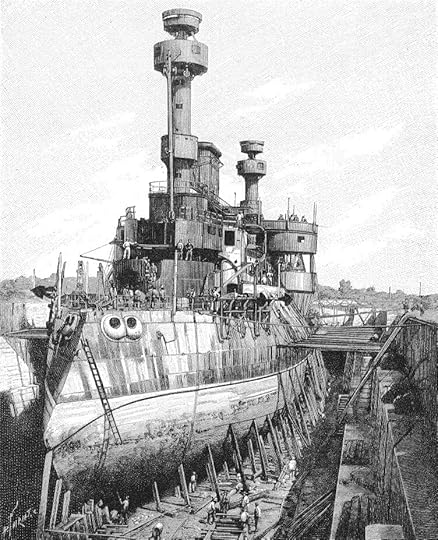
Hoche in drydock. Note the pointed ram
Heading for an unscheduled appointment with the Hoche on July 7th 1892 was the passenger steamer Maréchal Canrobert. Built in Scotland, and in service since 1881, this 1200-ton 250-foot iron-hull vessel carried mail and passengers between France itself and the French possessions in North Africa.
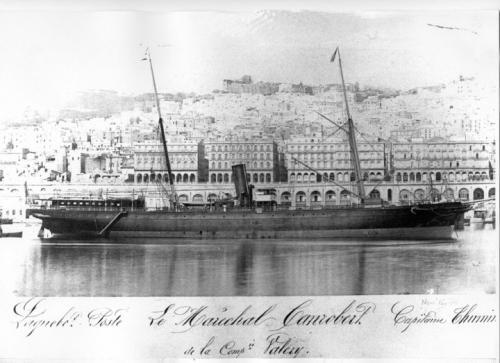
Maréchal Canrobert
On the day of the disaster, the Maréchal Canrobert was nearing Marseilles, following an uneventful passage from Bone (now known as Annaba) in Algeria. Some none miles south-west of her destination, the Maréchal Canrobert encountered the Hoche exercising in company with other naval units of the Mediterranean Fleet. Contemporary newspaper accounts are light on detail but an impression is gained that the Maréchal Canrobert’s captain brought his ship dangerously close to the warships, possibly to provide a better view of their manoeuvres to the passengers on deck. The Hoche had been firing her guns – and the propellants of the time yielded vast clouds of dense gunsmoke – and it was surmised that the Hoche’s officers did not see the passenger steamer until it was too late to take evasive action.
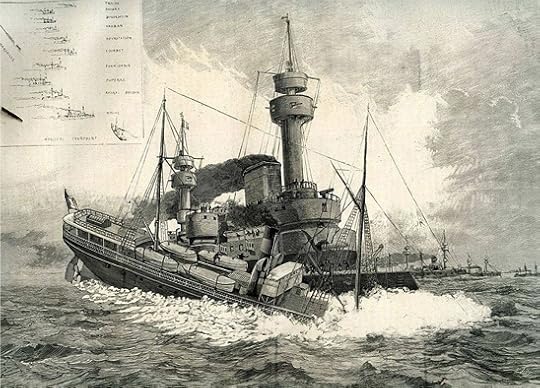
Contemporary illustration of the disaster
The Hoche’s ram bit deep into the Maréchal Canrobert, all but severing her in two. Naval disciple prevailed however and the shattered – and sinking – remains were secured to the battleship to facilitate transfer of survivors and boats were also launched. Despite these efforts the Maréchal Canrobert disappeared within eight minutes of the collision. The resulting death-toll amounted to 107. Blame for the disaster was placed on the captain of the Maréchal Canrobert.
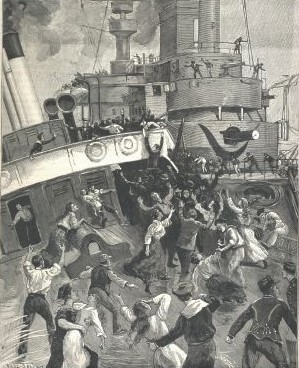
Survivors being brought on board Hoche
The ram had claimed yet another peacetime victim but some two decades were to pass before such bows finally passed out of fashion. Such is the power of the paradigm.
Britannia’s SharkThis volume of the Dawlish Chronicles series of historical naval novels centres on the development – and role – of a prototype submarine. Based on actual events and personalities in the early 1880s, Britannia’s Shark paints a vivid picture of the skills and courage – bordering on madness – which was needed to operate such craft. Click here or on image below for more details.
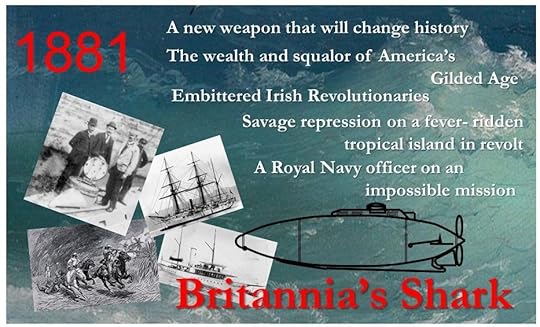 Below are the nine Dawlish Chronicles novels published to date, shown in chronological order. All can be read as “stand-alones”. Click on the banner for more information or on the “BOOKS” tab above. All are available in Paperback or Kindle format and can be read at no extra charge by Kindle Prime Subscribers.
Below are the nine Dawlish Chronicles novels published to date, shown in chronological order. All can be read as “stand-alones”. Click on the banner for more information or on the “BOOKS” tab above. All are available in Paperback or Kindle format and can be read at no extra charge by Kindle Prime Subscribers.

Six free short-stories are available for download to your Kindle. Access them by registering for the Dawlish Chronicles ma iling list – just click on the banner below. You’ll be kept updated on new books and will receive other free stories at intervals.
.fusion-body .fusion-builder-column-0{width:100% !important;margin-top : 0px;margin-bottom : 0px;}.fusion-builder-column-0 > .fusion-column-wrapper {padding-top : 0px !important;padding-right : 0px !important;margin-right : 1.92%;padding-bottom : 0px !important;padding-left : 0px !important;margin-left : 1.92%;}@media only screen and (max-width:1024px) {.fusion-body .fusion-builder-column-0{width:100% !important;}.fusion-builder-column-0 > .fusion-column-wrapper {margin-right : 1.92%;margin-left : 1.92%;}}@media only screen and (max-width:640px) {.fusion-body .fusion-builder-column-0{width:100% !important;}.fusion-builder-column-0 > .fusion-column-wrapper {margin-right : 1.92%;margin-left : 1.92%;}}.fusion-body .fusion-flex-container.fusion-builder-row-1{ padding-top : 0px;margin-top : 0px;padding-right : 20px;padding-bottom : 0px;margin-bottom : 0px;padding-left : 20px;}The post Hoche Ramming Disaster 1892 appeared first on dawlish chronicles.
October 14, 2021
18th Century Naval Artists Part 2
 Naval Artists of the 18th Century – Part 2
Naval Artists of the 18th Century – Part 2Creating the Image of the British Seaman
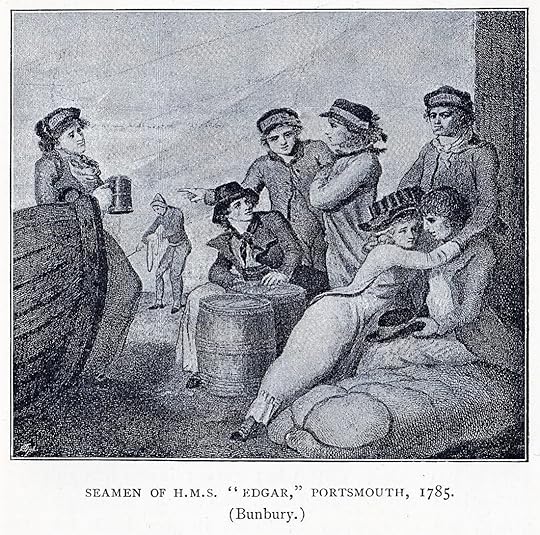
In the first part of this occasional series, which appeared on my blog recently, I discussed the remarkable career of Philippe-Jacques de Loutherbourg. (Click here to read if you missed it then.) He was a painter of considerable renown who produced remarkable pictures of naval actions but it is likely that the vast majority of people in that period never had the opportunity to see them, or others like them. In that age of great naval engagements, and in which the seaman came to be seen as a heroic – though poorly remunerated – figure, it is likely that the popular image was created by engravings and prints. Often, but not invariably, based on larger paintings, these could be cheaply produced and sold at prices affordable by all but the poorest homes. For residents of inland towns and rural areas, some of whom may have gone through life without seeing the sea or a seaman, these prints provided the image of “Rule Britannia” incarnate. Frequently framed, they were to prove of great longevity – and indeed a country public-house near my previous home has got a large number which have possibly hung there since they were purchased two centuries or more ago.
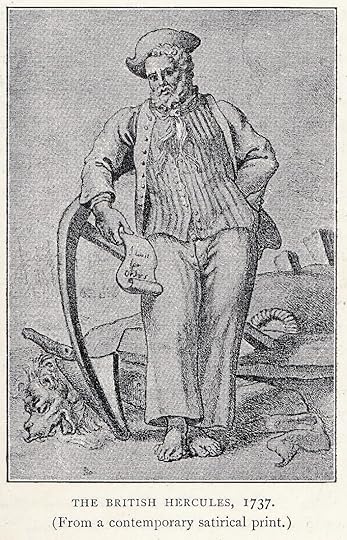 Cheap as such prints were they were often based on work by artists of the first order. They are frequently humorous, often sentimental, and though the tone is often unheroic, even anti-heroic, one gets a strong impression of the pride, brash confidence and carelessness for danger that characterised the seamen of the time. One can well imagine them squandering their meagre pay on drink and women, throwing away in an evening the prize-money they had dreamed of for years and grumbling and swearing incessantly – but one can also imagine them accepting cold, injury and brutal punishment stoically and fighting like tigers when the occasion demanded. From these prints a picture emerges of the men who beat the French in war after war through the 18th Century and who, at Trafalgar, were to secure British naval dominance for the next century.
Cheap as such prints were they were often based on work by artists of the first order. They are frequently humorous, often sentimental, and though the tone is often unheroic, even anti-heroic, one gets a strong impression of the pride, brash confidence and carelessness for danger that characterised the seamen of the time. One can well imagine them squandering their meagre pay on drink and women, throwing away in an evening the prize-money they had dreamed of for years and grumbling and swearing incessantly – but one can also imagine them accepting cold, injury and brutal punishment stoically and fighting like tigers when the occasion demanded. From these prints a picture emerges of the men who beat the French in war after war through the 18th Century and who, at Trafalgar, were to secure British naval dominance for the next century.
According to a Late-Victorian source (The British Fleet by C.N.Robinson, 1894), the earliest known depiction of a British blue-jacket was “The British Hercules”, dated 1737. He holds a scroll that says “I wait for orders” and this may refer to the two-years of fruitless negotiations with Spain which were then in progress – leading eventually to the splendidly-named War of Jenkin’s Ear. The most memorable exploit of the Royal Navy in this conflict was Anson’s voyage around the world in HMS Centurion.
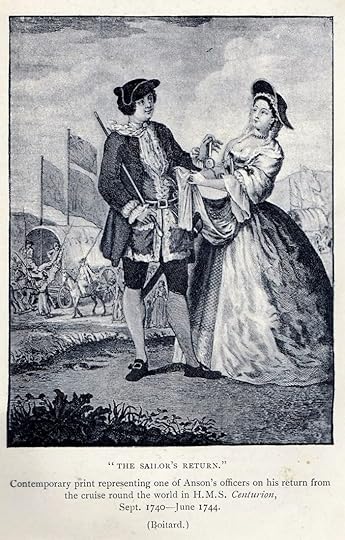 An engraving by Boitard entitled “The Sailor’s Return” shows an officer who has come back with Anson and in the background the treasure captured in the Spanish “Manilla Galleon” is being conveyed to London under the armed escort of sailors and marines. Louis Philippe Boitard was of French extraction, but settled in London. Robinson notes rather primly that “Some of Boitard’s pictures are too coarse for reproduction, notably that of “The Strand in an Uproar” – some sailors retaliating for the ill-treatment of one of their messmates in a house of ill-fame by throwing the furniture into the street”. I regret that I have been able to find a copy to include with this article!
An engraving by Boitard entitled “The Sailor’s Return” shows an officer who has come back with Anson and in the background the treasure captured in the Spanish “Manilla Galleon” is being conveyed to London under the armed escort of sailors and marines. Louis Philippe Boitard was of French extraction, but settled in London. Robinson notes rather primly that “Some of Boitard’s pictures are too coarse for reproduction, notably that of “The Strand in an Uproar” – some sailors retaliating for the ill-treatment of one of their messmates in a house of ill-fame by throwing the furniture into the street”. I regret that I have been able to find a copy to include with this article!
The great painter and engraver William Hogarth (1697-1764)) also referred to the Centurion’s returning crew. In “The Stage Coach in a Country Inn Yard” he puts a soldier and a seaman on top of the carriage. The soldier looks woebegone (perhaps he had been at Dettingen or Fontenoy?) whereas the sailor is well pleased with himself, probably because the bundle he has with him is marked Centurion and has prize-money to enjoy. He, or a sailor very similar, also appeared in Hogarth’s engraving of “The Times – Plate 1”, in which he carries buckets to help to put out a fire.
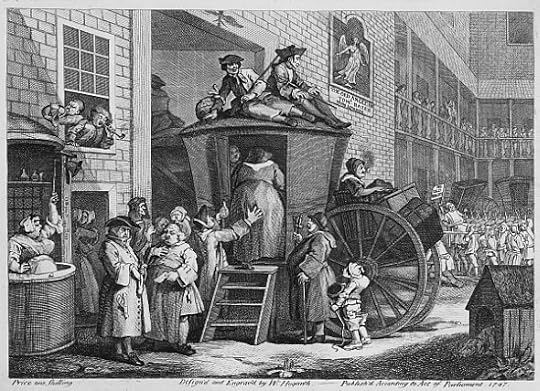
Hogarth – “The Stage Coach in a Country Inn Yard”
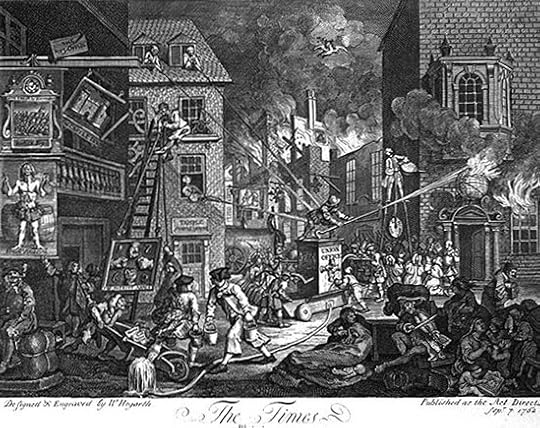
Hogarth – “The Times, Plate 1”. Note the seaman at the centre.
The riotous behaviour of seaman ashore, half-condemned, half admired, was a common and entertaining subject. John Collet (1725-80) was an artist in the satirical Hogarth tradition. In “A Rescue, or the Tars Triumphant” he shows an actual incident in 1768 when a press-gang rescued their officer’s “young lady friend” from the hands of the law. There may be little doubt regarding the young lady’s profession and one is struck how in a large number of prints seamen are seen enjoying themselves with obviously “loose women” in a way which no doubt continue into the Victorian period, but which could never then have been treated with such sympathy and amusement. Eminent members of the Royal Academy such as Thomas Stothard (1755-1834) and Henry Singleton (1766-1839) did not hesitate to show such scenes, as below.
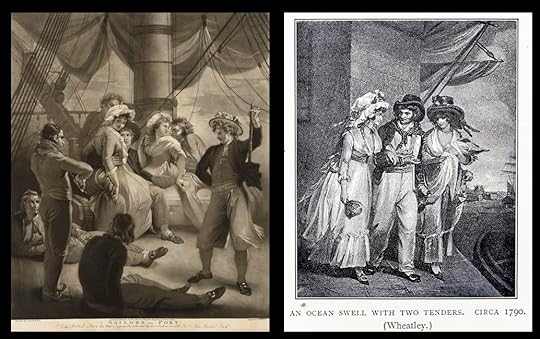
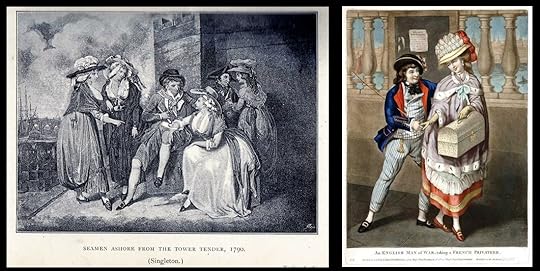
Note: “An ENGLISH MAN of WAR taking a FRENCH PRIVATEER”!
Pay which was accumulated on long voyages – or prize money – tended to be spent in very short order once crews finally came ashore. The respected painter Robert Dighton (1752-1814) and the cartoonist Isaac Cruikshank (1764-1811) depicted just how fast and furious the spree could be – see below.
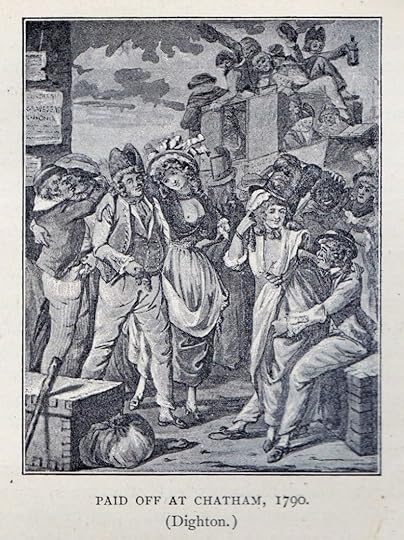
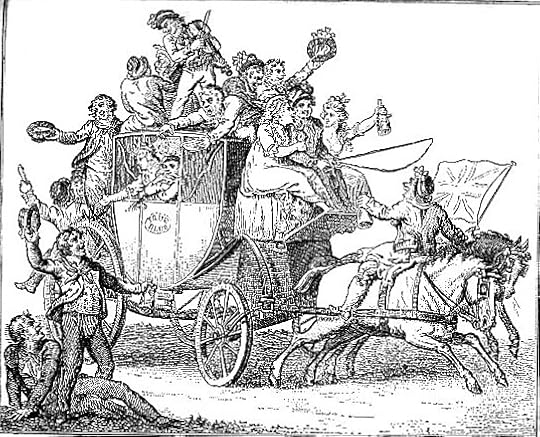
Cruikshank – “Paid off at Chatham”
The image of the devil-may-care seaman carried on beyond the Napoleonic War s, as shown in the insolence of “Jack’s Wedding Day” below.
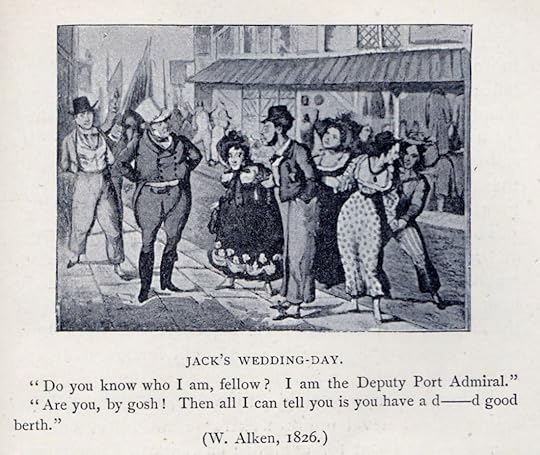
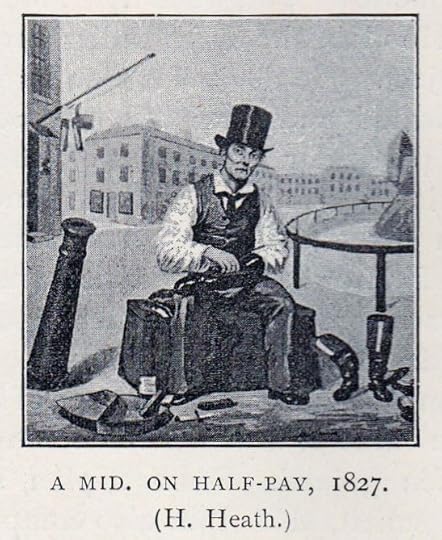 A sadder commentary on the war’s aftermath, when many men were discharged and officers put on half-pay, shows a mid-shipman sitting on his sea-chest and reduced to working in the street as a shoe-shine.
A sadder commentary on the war’s aftermath, when many men were discharged and officers put on half-pay, shows a mid-shipman sitting on his sea-chest and reduced to working in the street as a shoe-shine.
It is however better to close with some of the more benign – and often touching – images of seamen restored to loved ones or returning to long-term absence at sea, with a significant chance of injury or death. In these images too we find something of what made this age one of greatness for Britain, and of what the price for it could be for humble people.
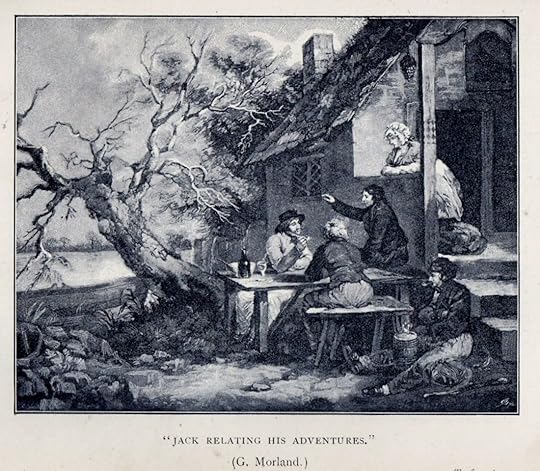
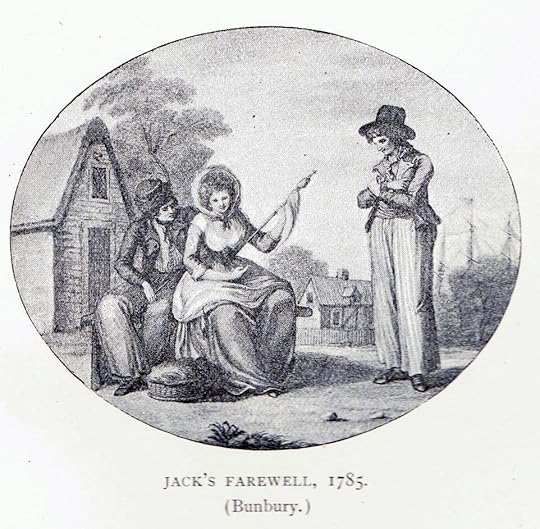
 It’s 1877 and the vicious Russo-Turkish War is reaching its climax.
It’s 1877 and the vicious Russo-Turkish War is reaching its climax.
A Russian victory will pose a threat to Britain’s strategic interests. To protect them an ambitious British naval officer, Nicholas Dawlish, is assigned to the Ottoman Navy to ravage Russian supply lines in the Black Sea. In the depths of a savage winter, as Turkish forces face defeat on all fronts, Dawlish confronts enemy ironclads, Cossack lances and merciless Kurdish irregulars, and finds himself a pawn in the rivalry of the Sultan’s half-brothers for control of the collapsing empire. And in the midst of this chaos, unwillingly and unexpectedly, Dawlish finds himself drawn to a woman whom he believes he should not love.
Neither for his own sake, nor for hers…
Britannia’s Wolf features a naval hero who is more familiar with steam, breech-loaders and torpedoes than with sails, carronades and broadsides. Dawlish joined as a boy a Royal Navy still commanded by veterans of Trafalgar but he will help forge the Dreadnought navy of Jutland and the Great War. Other books in the series follow him further along that path. Click here, or on the cover image, for more details.
Below are the nine Dawlish Chronicles novels published to date, shown in chronological order. All can be read as “stand-alones”. Click on the banner for more information or on the “BOOKS” tab above. All are available in Paperback or Kindle format and can read at no extra charge by Kindle Unlimited or Kindle Prime Subscribers.
Six free short-stories are available for download to your Kindle. Access them by registering for the Dawlish Chronicles ma iling list – just click on the banner below. You’ll be kept updated on new books and will receive other free stories at intervals.
Share This Story, Choose Your Platform!.fusion-body .fusion-builder-column-0{width:100% !important;margin-top : 0px;margin-bottom : 0px;}.fusion-builder-column-0 > .fusion-column-wrapper {padding-top : 0px !important;padding-right : 0px !important;margin-right : 1.92%;padding-bottom : 0px !important;padding-left : 0px !important;margin-left : 1.92%;}@media only screen and (max-width:1024px) {.fusion-body .fusion-builder-column-0{width:100% !important;}.fusion-builder-column-0 > .fusion-column-wrapper {margin-right : 1.92%;margin-left : 1.92%;}}@media only screen and (max-width:640px) {.fusion-body .fusion-builder-column-0{width:100% !important;}.fusion-builder-column-0 > .fusion-column-wrapper {margin-right : 1.92%;margin-left : 1.92%;}}.fusion-body .fusion-flex-container.fusion-builder-row-1{ padding-top : 0px;margin-top : 0px;padding-right : 20px;padding-bottom : 0px;margin-bottom : 0px;padding-left : 20px;}The post 18th Century Naval Artists Part 2 appeared first on dawlish chronicles.
October 7, 2021
Enter the Imperial German Navy on the World’s Oceans
 The Arrival of the Imperial German Navy on the World’s Oceans
The Arrival of the Imperial German Navy on the World’s OceansNovember 30th 2018 saw the publication of the seventh novel in the Dawlish Chronicles series, Britannia’s Mission. Like all books in the series, the plot and action are linked to real events, persons and political developments. Set in 1883, one of the major themes is the arrival of the young Imperial German Navy on the world’s oceans and growing German interest in colonial expansion. (Details of the book at the end of this article). This article focuses on the creation of a naval fighting force that was to be characterised by professionalism and efficiency from the very start.
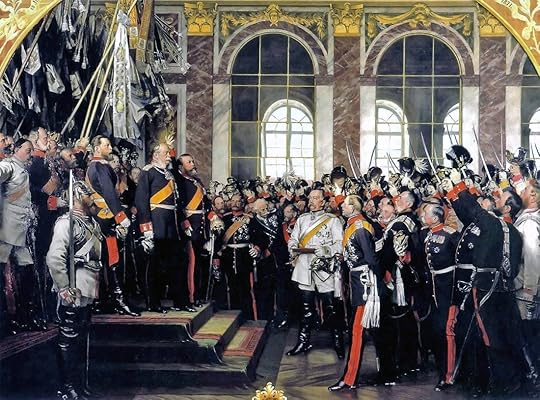
The proclamation of the German Empire at Versailles, 18th January 1871
German unification was finally achieved in January 1871 when the King of Prussia was proclaimed Kaiser Wilhelm I of the new German Empire by the monarchs and rulers of the individual German states, some of which had sided with Austria-Hungary in its war with Prussia less than five years before. The event took place in the Palace of Versailles while Paris was under siege by German forces – the prelude to the crushing defeat of France that would see now-imperial German troops parade triumphantly through its capital only six weeks later.
Sea power had played no significant role in the war. French ineptitude had prevented it using its overwhelming naval superiority to impost a strict blockade on German ports. The naval forces available to the North German Confederation, comprising Prussia and other states, were too few and too weak to exploit this situation (which provides the background to my novel Britannia’s Innocent, set in “Bismarck’s First War”, the Danish War of 1864).
Victory in the Franco-Prussian War made the new German Empire and its army the greatest military power in Mainland Europe. In the war’s immediate aftermath little attention was paid to creation of an equally powerful navy – its role was seen primarily to be one of coast defence. Vessels constructed in the 1870s reflected this and, though the Imperial German Navy was established as an independent organisation, its overall command was entrusted to senior army officers until 1887.
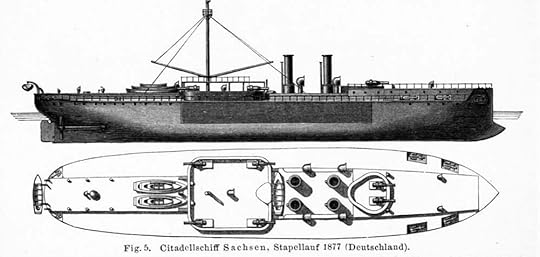
SMS Sachsen – three like her followed
The first “modern” German cost defence vessels were of the four-ship Sachsen class, 7,635 tons and 322-ft long. Built between 1877 and 1880, they were designed to operate as part of an integrated coastal defence network and intended to sortie from fortified bases to break up enemy blockades or attempted landings. They were to operate close to shore and not on the high seas. Armed with six 10-inch guns in open barbettes, as well as smaller weapons, the Sachsens were powerful ships for the time. Their unusual layout allowed at least two of her 10-inch guns to fire on all bearings. (As in other navies, blast-effects on the decks and superstructure seem to have been disregarded or underestimated). Their four funnels, set at the corners of a rectangle, apparently suggested the nickname of “The Cement Factories”.
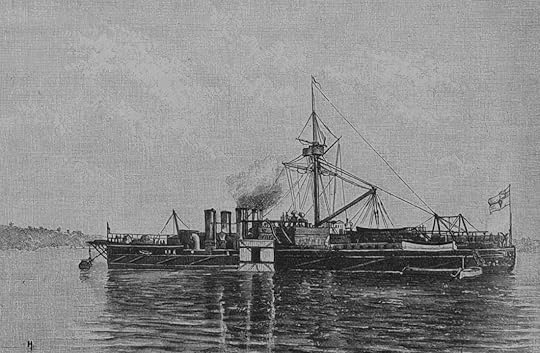
SMA Bayern – one of the unlovely Sachsen class
As part of this coast defence strategy significant expenditure was made on construction of two new fortified bases, Kiel on the Baltic Coast and Wilhelmshaven on the North Sea. The construction of the Kiel Canal, commenced in 1887, linked the Baltic and North Seas, and rapid transfer of warships between them when required. The focus on coast defence continued until the 1890s, when the first class of ocean-going battleships, the Brandenburgs, were constructed.
Well in advance of this however, other German warships had been seen on the world’s oceans from the early 1880s onwards. There were two drivers: (1) the need for training officers and seamen to the same standards of professionalism and efficiency as the German Army and (2) growing German interest in acquisition of overseas colonies. The first was obvious from the start but it was not for a decade after the victory over France that Chancellor Otto von Bismarck was persuaded that colonies could indeed be desirable. The pressure for them came initially from commercial enterprises intent on securing access to overseas markets and natural resources. In several cases independent freebooters and visionaries forced the pace by their own efforts to establish a German presence, and in the process they forced the government to follow suit.
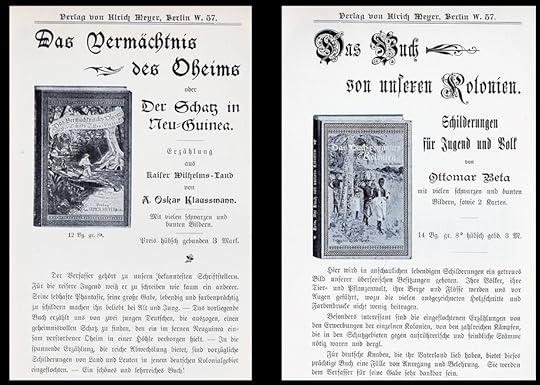 Adventure stories set in e.g. New Guinea (L) or East Africa (R) roused interest and pride in the colonies
Adventure stories set in e.g. New Guinea (L) or East Africa (R) roused interest and pride in the colonies
The results were spectacular. In the thirty years up to World War 1 Germany acquired large and wide-spread territories, not just in Africa (what are now Namibia, Tanzania, Togo and Cameroon), but in Northern New Guinea (“Kaiser Wilhelmland”), New Pomerania (now New Britain), the Bismarck Archipelago, and the Solomon, Caroline, Marshall and Marianas island groups of the Western Pacific which became major battlegrounds in World War 2. Germany also tried, unsuccessfully, to buy the Philippines from Spain in 1898, before the US could establish a presence there in the aftermath of the Battle of Manila Bay. In due course Germany would also have a naval base, Tsingtao, on the Chinese coast. Settlement in these colonies by Germans was sparse – there may have been more Germans living in France in 1914 than in all the colonies put together.
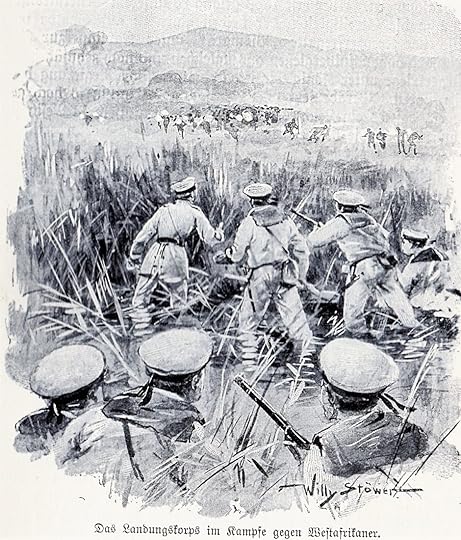
Landed seamen played important roles in Germany’s colonial campaigns
Support of these colonies demanded, on occasion, naval support. As with the “Naval Brigades” that were so characteristic of Royal Navy responsibilities in this era, the Imperial German Navy proved equally adept of sending seamen ashore in an infantry role, supported as necessary by gunfire from their ships. One of the earliest of such actions was intervention in a civil war in Samoa in 1887 and 1888. The ships needed high endurance and range. Retention of sailing rigs to complement their steam engines was desirable in stretches of ocean where coal supplies would be hard to come by. An added advantage was that such ships proved ideal for training purposes, and for rapid fostering of a naval tradition, ethos and espirit-de-corps in a recently created navy.
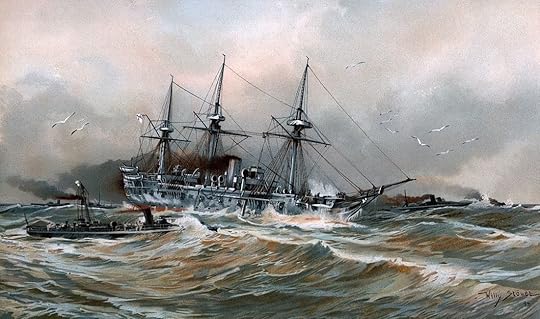
SMS Blücher of the Bismarck-class exercising with torpedo boats – painting by Willy Stöwer
Typical of the “blue water” German ships of the period were the six ships of the Bismarck-class, built in the 1875-1880 period. Of some 3000-tons and 270-ft, these vessels carried a powerful armament of ten 5.9-inch breech-loaders. The large crews that could be accommodated – some 380 men – made them ideal ships for training. All saw service on a global basis, including support of colonial acquisitions.
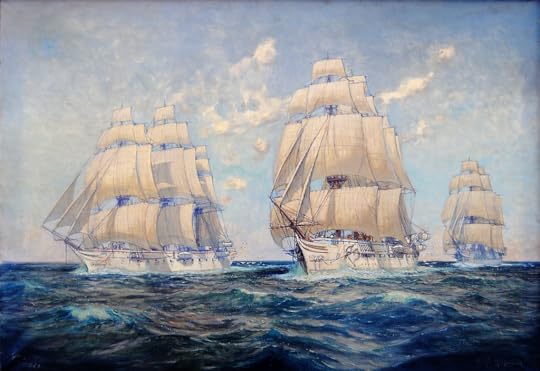
SMS Stosch, Stein, and Gneisenau of the Bismarck-class under sail, by Alexander Kircher
Even more impressive was the last sail-equipped warship constructed for the Imperial Navy. SMS Charlotte was commissioned in 1886. Of 3700-tons and 275-ft length, she carried no less than eighteen 5.9-in guns and had accommodation for a crew in excess of 500. This suited her training naval cadets and apprentice seamen, which she did for her entire career, her 3100-hp engines, which have her a maximum speed of 13.5 knots, providing exposure to steam machinery as well as navigation, gunnery and sailing skills. She cruised widely overseas and in 1899 had the distinction of making the first visit of a German warship to French ports since the Franco-Prussian War.
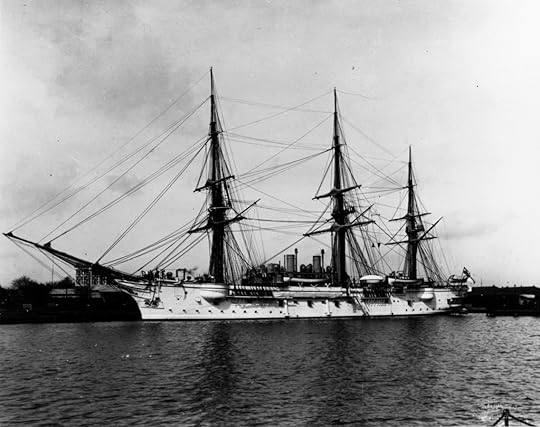
SMS Charlotte
Imperial Germany participated in no major international conflicts in the years between 1871 and 1914, though there were many minor colonial interventions and participation in anti-Boxer operations in China. When war did however come in the latter year it was equipped with a navy second only to the Royal Navy in strength and with officers and men trained to a superb level of professionalism.
And the foundation for that professionalism was laid by vessels such as SMS Charlotte.
Britannia’s MissionIn which the new Imperial German Navy plays a significant role . . .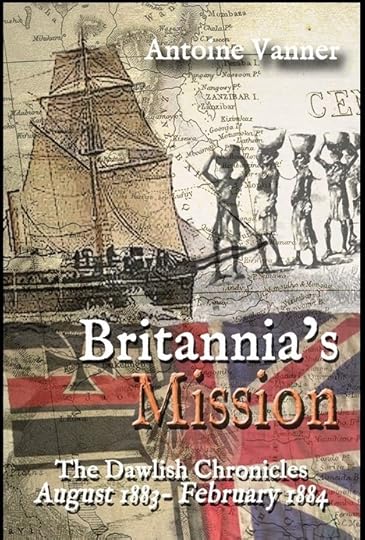
Click image for details or to order
1883: The slave trade flourishes in the Indian Ocean, a profitable trail of death and misery leading from ravaged African villages to the insatiable markets of Arabia. Britain is committed to its suppression but now there is pressure for more vigorous action . . .
Two Arab sultanates on the East African coast control access to the interior. Britain is reluctant to occupy them but cannot afford to let any other European power do so either. But now the recently-established German Empire is showing interest in colonial expansion . . .
With instructions that can be disowned in case of failure, Captain Nicholas Dawlish must plunge into this imbroglio to defend British interests. He’ll be supported by the crews of his cruiser HMS Leonidas, and of a smaller warship. But it’s not going to be so straightforward . . .
Getting his fighting force up a shallow, fever-ridden river to the mission is only the beginning for Dawlish. Atrocities lie ahead, battles on land and in swamp also, and strange alliances must be made.
And the ultimate arbiters may be the guns of HMS Leonidas and those of her counterpart from the Imperial German Navy.
In Britannia’s Mission Nicholas Dawlish faces cunning, greed and limitless cruelty. Success will be elusive . . . and perhaps impossible.
Click here or on the cover image above for details or to orderThe Dawlish Chronicles – now up to nine volumes and with the tenth due for launch in December 2021 …Below are the nine Dawlish Chronicles novels published to date, shown in chronological order. All can be read as “stand-alones.” Click on the banner for more information or on the “BOOKS” tab above. All are available in Paperback or Kindle format and can read at no extra charge by Kindle Unlimited Subscribers.
Six free short-stories are available for download to your Kindle. Access them by registering for the Dawlish Chronicles ma iling list – just click on the banner below. You’ll be kept updated on new books and will receive other free stories at intervals.
.fusion-body .fusion-flex-container.fusion-builder-row-2{ padding-top : 0px;margin-top : 0px;padding-right : 20px;padding-bottom : 0px;margin-bottom : 0px;padding-left : 20px;}The post Enter the Imperial German Navy on the World’s Oceans appeared first on dawlish chronicles.
October 1, 2021
Disaster in the North Sea 1811 – HMS Hero
 The wreck of HMS Hero, 1811
The wreck of HMS Hero, 1811Though the Revolutionary and Napoleonic Wars involved some two decades of continuous conflict, in which control of the sea was a vital consideration for Britain, many of hundreds of Royal Navy vessels involved were never exposed to direct combat with the enemy. Bad weather was however a constant hazard, especially in this era when modern aids to navigation and communication did not yet exist and when a vessel under sail did not have the ability to propel herself clear of danger with the ease that steam power would shortly bring. In no case is this better illustrated than by a storm in 1811 in which two “74” ships of the line, HMS Defence, and HMS Hero, and a “98”, HMS St. George, and a myriad of smaller craft were lost in a single storm that raged across the entire North Sea. This article will concentrate of the wreck of HMS Hero.
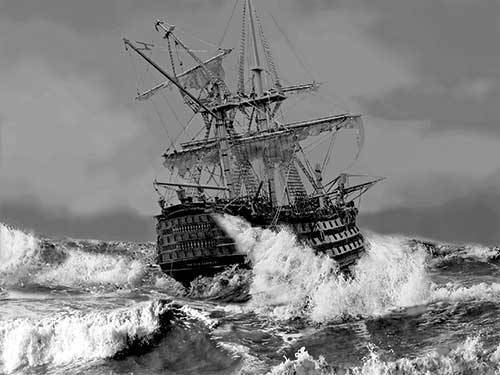
The Wreck of HMS St. George 24.12.1811
During this period, as in WW1 and WW2, Britain’s ability to remain in the fight depended very heavily on imports. In these later conflicts, the need to protect importation of food, oil, munitions and other supplies from the Americas made the Atlantic a major battle-ground. In the late 18th and early 19th Century, however, the most vital imports for maintenance of Britain’s war-making ability depended on “naval stores” – wood and related products imported from the Baltic region. This in due course led to the Baltic itself, and the exit from it, and the Southern North Sea, becoming areas of major strategic importance. Given the very limited capacity – by modern standards – of the merchant ships of the time, the numbers of vessels involved were quite immense. One convoy that arrived in Britain from the Baltic in September 1810 consisted of between five and six hundred merchantmen, the largest convoy up to that time. Such convoys needed protection against fast enemy privateers or naval frigates, thereby necessitating strong escort forces. Keeping track and control of such vast numbers of ships in the absence of radio and radar, not to mention weather-forecasting, was a nightmare for escort commanders. Losses to storms were high and even large vessels were at risk, such as the “74” ship-of-the-line HMS Minotaur, which was wrecked off the Dutch island of Texel in 1810. She had been driven into shallow water where she was beaten to destruction by the waves, with heavy loss of life. Worse was to follow – and in the same area – in the next year.
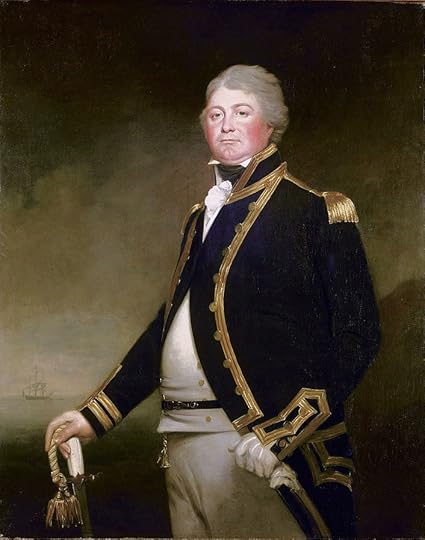 HMS Hero, a relatively new “74”, launched in 1803 had come under the command of Captain James Newman-Newman (1767 – 1811) – see portrait on right – in 1808. Newman had a distinguished career both as a junior officer and as a commander of frigates, and in 1810 his ship formed part of the squadron protecting Baltic commerce, including the enormous convoy alluded to above. 1811 saw similar work and in December of that year he was tasked with escorting a convoy from Gothenburg, in Southern Sweden, to London. Newman seems to have doubted the prudence of sending ships home in this season and apparently remarked “I cannot help thinking that we have been detained too long, and it is well if some of us do not share the fate of the Minotaur.”
HMS Hero, a relatively new “74”, launched in 1803 had come under the command of Captain James Newman-Newman (1767 – 1811) – see portrait on right – in 1808. Newman had a distinguished career both as a junior officer and as a commander of frigates, and in 1810 his ship formed part of the squadron protecting Baltic commerce, including the enormous convoy alluded to above. 1811 saw similar work and in December of that year he was tasked with escorting a convoy from Gothenburg, in Southern Sweden, to London. Newman seems to have doubted the prudence of sending ships home in this season and apparently remarked “I cannot help thinking that we have been detained too long, and it is well if some of us do not share the fate of the Minotaur.”
Newman’s convoy sailed the December 18th, 1811, under escort of HMS Hero and the 18-gun sloops HMS Egeria and HMS Grasshopper. From the beginning, the weather was tempestuous and two days later the Egeria parted company, leaving the other two warships with some eighteen merchantmen. Due to the weather – and possibly due to a malfunctioning chronometer – exact fixing of location proved impossible and in mid-morning on December 24th Captain Newman, signalled to the Grasshopper that the vessels were now in the region of the so-called Silver Pit, an area of the North Sea some 30 miles east of Spurn Head on England’s North Sea Coast. On this assumption, he confirmed that the convoy should proceed south-west. The estimated position was dangerously wrong – the actual position was over 150 miles south of east and in shallow waters off the large Dutch island of Texel.
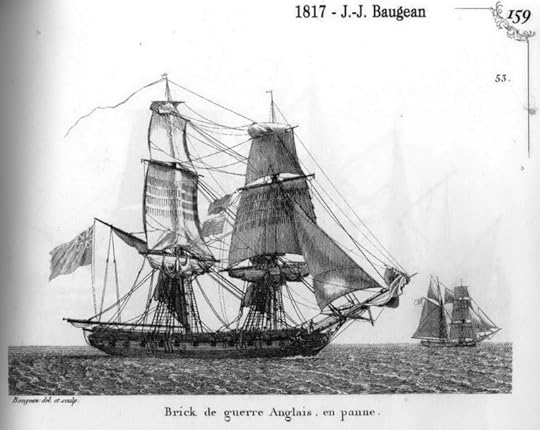
Typical Royal Navy Sloop – HMS Grasshopper would have looked generally similar
What happened in the following hours was testified to by the officers of the Grasshopper. With a following wind, this sloop was making nine knots. Four ships of the convoy were still in view but were soon lost sight of in the heavy squall of snow and sleet. Driving blindly ahead, the Grasshopper found herself in broken water in mid-afternoon. Shortly later she struck bottom, was lifted by the waves and was carried into deeper water, some six fathoms. A bow anchor was dropped but the vessel, at the end of the cable, struck bottom again shortly after and continued to pound in the coming hours.
It was now night, but through the darkness HMS Hero was identified – apparently at anchor also, and burning blue lights and firing guns. This ended during the night and when daylight dawned it was seen that both vessels were about six miles off Texel. Hero lay about a mile from Grasshopper but was by now a total wreck, lying on the seabed on her starboard side with the sea breaking over her. The ship’s company were crowded together on the poop and forecastle and at the mercy of the breaking waves which were sweeping many away. Though herself in dire straits – and in danger of breaking up – an attempt was made by the crew of the Grasshopper to reach the Hero, but the surf ran so high that it proved impossible.
The plight of the two ships was visible from shore and the only hope was to call on the Dutch enemy for assistance. The Hero accordingly hoisted a flag of truce and fired a gun. These signals were soon answered and several vessels putting out from the Texel to her relief – a remarkable action, given that Britain and the French-dominated Netherlands were at war. Due to the tidal conditions, and the gale blowing, these boats were unable however to get closer than three miles.
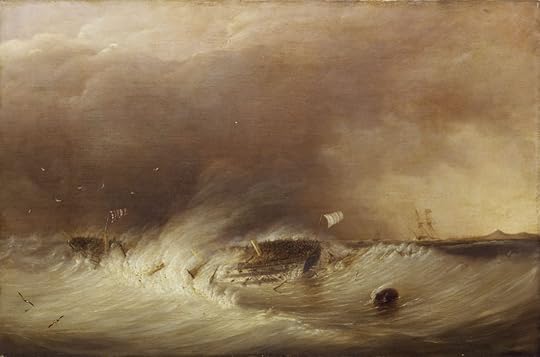
The end of HMS hero – see HMS Grasshopper and Texel shore to the right
Painting by Archer James Oliver (1774 – 1842)
The anchored Grasshopper was still pounding on the bottom and her situation too was clearly desperate. With night coming on, and no let-up in the storm her Captain Fanshawe, with the support of his officers, decided that there was no option for saving the lives of the crew than surrendering to the Dutch. The cable was cut, and the Grasshopper managed to reach den Helder, just south of Texel, then, as now, the main Dutch naval base and surrendered. The Hero went to pieces during the night and in the morning not a vestige of her was to be seen. The Dutch forces made every effort to save the crew, but the weather was so stormy that it proved abortive. Only twelve men were rescued from a crew of about five hundred and Captain Newman-Newman was not among them. This was not the only loss for the convoy, for ten of its transports were also lost.
On the previous day, a separate tragedy was played out some 230 miles to the north-east, where the two ships of the line, HMS St. George and HMS Defence were driven on to the Danish coast. Here also the loss of like was horrific. From a combined total of both crews, 1356 men, only 21 were saved.
The risks involved in Britain’s maintaining command of the sea in the Age of Fighting Sail have seldom been more terribly illustrated.
Like naval fiction? Try Britannia’s Wolf It’s 1877 and the vicious Russo-Turkish War is reaching its climax.
It’s 1877 and the vicious Russo-Turkish War is reaching its climax.
A Russian victory will pose a threat to Britain’s strategic interests. To protect them an ambitious British naval officer, Nicholas Dawlish, is assigned to the Ottoman Navy to ravage Russian supply-lines in the Black Sea. In the depths of a savage winter, as Turkish forces face defeat on all fronts, Dawlish confronts enemy ironclads, Cossack lances and merciless Kurdish irregulars, and finds himself a pawn in the rivalry of the Sultan’s half-brothers for control of the collapsing empire. And in the midst of this chaos, unwillingly and unexpectedly, Dawlish finds himself drawn to a woman whom he believes he should not love.
Neither for his own sake, nor for hers…
Britannia’s Wolf features a naval hero who is more familiar with steam, breech-loaders and torpedoes than with sails, carronades and broadsides. Dawlish joined as a boy a Royal Navy still commanded by veterans of Trafalgar but he will help forge the Dreadnought navy of Jutland and the Great War. Other books in the series follow him further along that path. Click here, or on the cover image, for more details.
Below are the nine Dawlish Chronicles novels published to date, shown in chronological order. All can be read as “stand-alones”. Click on the banner for more information or on the “BOOKS” tab above. All are available in Paperback or Kindle format and can read at no extra charge by Kindle Unlimited or Kindle Prime Subscribers.
Six free short-stories are available for download to your Kindle. Access them by registering for the Dawlish Chronicles ma iling list – just click on the banner below. You’ll be kept updated on new books and will receive other free stories at intervals.
.fusion-body .fusion-builder-column-0{width:100% !important;margin-top : 0px;margin-bottom : 0px;}.fusion-builder-column-0 > .fusion-column-wrapper {padding-top : 0px !important;padding-right : 0px !important;margin-right : 1.92%;padding-bottom : 0px !important;padding-left : 0px !important;margin-left : 1.92%;}@media only screen and (max-width:1024px) {.fusion-body .fusion-builder-column-0{width:100% !important;}.fusion-builder-column-0 > .fusion-column-wrapper {margin-right : 1.92%;margin-left : 1.92%;}}@media only screen and (max-width:640px) {.fusion-body .fusion-builder-column-0{width:100% !important;}.fusion-builder-column-0 > .fusion-column-wrapper {margin-right : 1.92%;margin-left : 1.92%;}}.fusion-body .fusion-flex-container.fusion-builder-row-1{ padding-top : 0px;margin-top : 0px;padding-right : 20px;padding-bottom : 0px;margin-bottom : 0px;padding-left : 20px;}The post Disaster in the North Sea 1811 – HMS Hero appeared first on dawlish chronicles.


